
Boating Basics Online is reader-supported. When you buy via our links, we may earn a commission at no cost to you. Learn more

A Sailboat is Underway in the Fog. What Sound Signal Should You Hear
Written by J. Harvey / Fact checked by S. Numbers
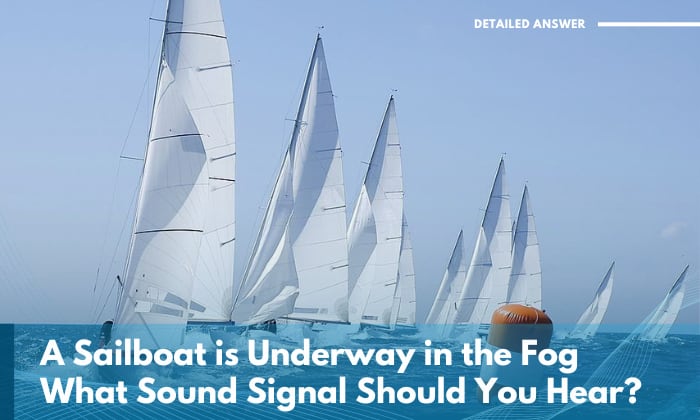
Consider this scenario: You’re sailing along in open waters with minimal visibility (i.e. restricted view). Soon enough, your instincts start wondering “a sailboat is underway in the fog. What sound signal should you hear?”
Assuming the one captaining the vessel is familiar with boating in fog signals, he or she should:
- Sound one prolonged blast plus two short blasts every two minutes lasting from four up to six seconds. These should be produced in intervals of at most two minutes.
- If the sailboat is motor-driven, the captain should sound one prolonged blast every two minutes or with the same interval as above.
Table of Contents
What is Restricted View? Rules for Operating
How to prepare for fog while boating, list of sounds and their meanings, common sounds, sounds to communicate with fellow boaters, sounds to make your location known, other signals.
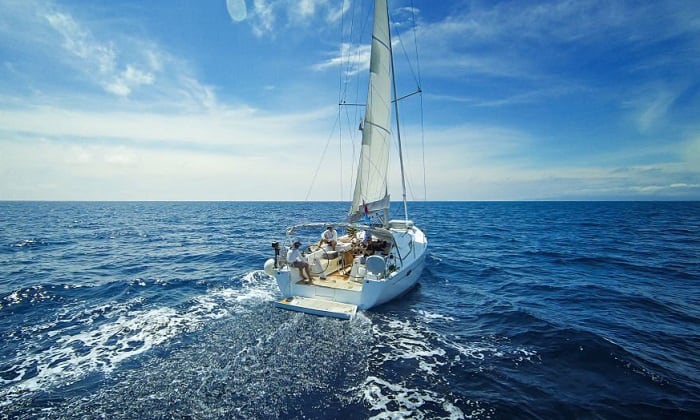
It’s an instance when various factors limit your view or ability to be seen any time you’re out sailing. It can be due to natural factors like weather conditions that bring plenty of rain and fog. Other vessels and even structures, natural or artificial, can affect it, too.
Knowing what to do during restricted visibility environments only ensures your safety. It’s not just about knowing what to hear when a powerboat is underway in the fog, but being familiar with a whole lot of regulations as outlined in COLREGS (Collision Regulations).
COLREGS rules when operating in conditions of reduced visibility can be summed up as follows:
- Boats must always operate at an appropriate speed based on the present conditions and limited visibility.
- Once you’ve detected another watercraft by radar, the first instinct should always be to evade it without delay.
- When complying with navigation rules, vessel operators must always factor in, if not prioritize, the specific conditions brought about by restricted view.
- Motor-powered vessels must always be ready to perform the necessary maneuver to avoid collisions. That answers the question, “What immediate action should you take?” if your boat belongs to that category.
- Once you hear the horn signal of the other vessel or can’t avoid coming near the vessel forwards of the boat’s beam, the first course of action should always be to decrease speed up to the minimum allowable to keep the vessel on course.
- Alter course to starboard for vessels forward of the beam; the same applies to vessels abeam or abaft the beam on the port quarter. Change course to port for boats abeam or abaft the beam on the starboard quarter.
- Certain evading actions are discouraged, such as altering course to port for a boat “forwards of the beam”, except if the intent is to overtake. The same goes for maneuvers towards a boat “abeam or abaft the beam”.
- Unless you’ve ascertained that there’s no longer any risk of collision with another vessel, always exercise extreme caution.
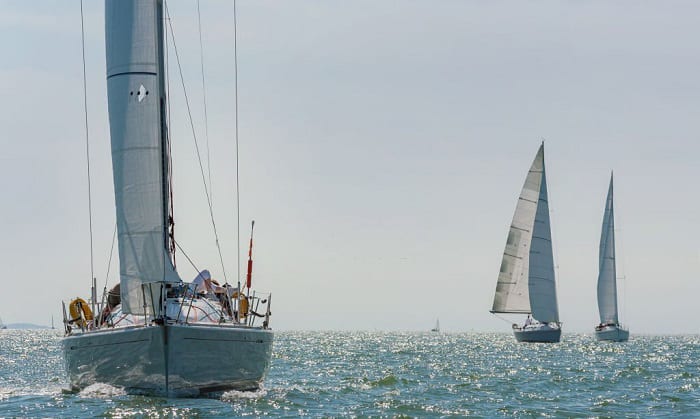
Besides learning horn signals for boats and standard procedures during limited visibility situations, it won’t hurt to be a few extra steps ahead to anticipate foggy conditions every time you take your boat out.
Here are a few strategies a lot of experienced skippers can attest to:
- Don’t be a speed demon as much as possible. Be open to stopping and anchoring anywhere and any time should the need arise (i.e. the fog gets too thick).
- Always check the weather forecast. Be mindful of how serious the possible fog conditions will be.
- Find the right crew to work with and instill in them the mindset that they should be ready to assist you during difficult and emergency situations. Having someone check how thick the fog is getting regularly is already a big help.
- Always inspect your boat’s safety equipment, especially the navigational lights and horns, before embarking. I can say the same for the electronics and emergency kits you bring along.
- When visibility is restricted due to fog, a GPS can be a literal godsend. Having a digital map of the immediate area and being able to know where your boat is currently, all available on a nifty screen, is hard to top.
It has definitely spared me from becoming my (usual) bundle of nerves if I find myself in extra-dense fog. Want proof? Here’s a video of Capt. Scott saying nice things about this helpful tool:
- Last but not least, always take the time to familiarize yourself with your boat. Know its capabilities and limitations, especially when making safety maneuvers during restricted-visibility conditions.
Besides the sailboat underway in fog signal mentioned here, you should also learn all the other sound signals that apply to restricted visibility:
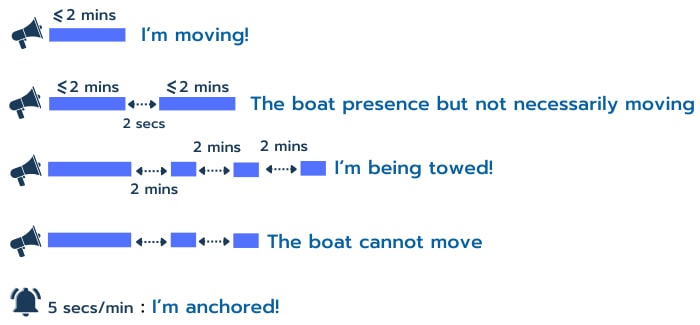
- One prolonged blast every 2 minutes
This means, “I’m moving!” and is made by a motor-driven vessel underway and moving through the water.
- Two prolonged horn blasts in succession with 2-second intervals every 2 minutes
The boat is underway but not progressing through the water. It simply announces its presence but not necessarily moving.
- One long horn blast followed by three short ones every 2 minutes.
This means, “I’m being towed!” so you have to steer clear of the boat.
- One prolonged blast and two short ones.
The boat cannot move, whether due to circumstances beyond its control (such as broken engines) or the work it’s doing (e.g. mine clearance, servicing pipelines).
- Bell rings for five seconds every minute.
This means, “I’m anchored!”. Generally used to warn other boats that the vessel is not moving.
Based on the pattern of the sound signals for boats as explained above, there are technically only two commonly-used sounds involved when warning other vessels: a short blast that typically lasts no more than a second and a long one that can last between 4 to 6 seconds.
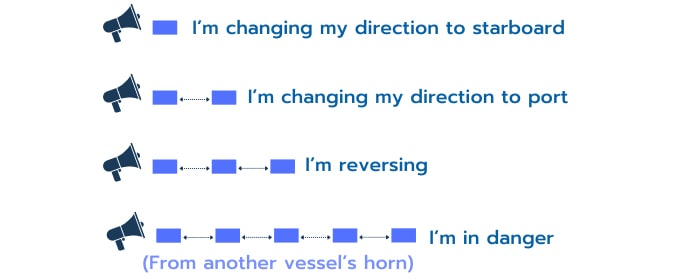
There are other boating sound signals that aren’t necessarily related to restricted visibility. These include the following:
- I’m changing my direction to starboard.
This is communicated with one short blast.
- I’m changing my direction to port.
Vessels emit two short blasts for this.
- I’m reversing.
You’ll hear three short blasts if the vessel is applying astern propulsion.
- I’m in danger.
When you hear 5 short blasts from another vessel’s horn, this typically connotes trouble. You can also use that sound pattern to say that you don’t understand or don’t agree with a vessel’s course of action.
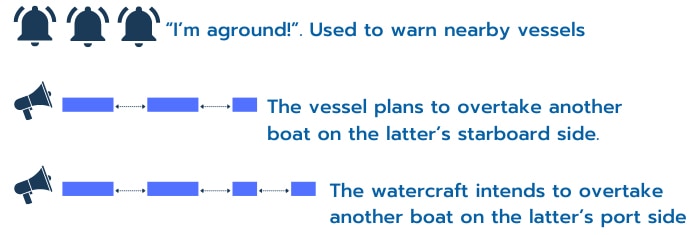
- Three separate bell strokes before or after rapid ringing.
This means, “I’m aground!”. Used to warn nearby vessels.
- Two long whistle blasts followed by one short one
This means the vessel plans to overtake another boat on the latter’s starboard side.
- Two long whistle blasts followed by two short ones
This means the watercraft intends to overtake another boat on the latter’s port side.
Besides sound signals, you can also use flags, flares, radio signals, hand signals, and emergency beacons to communicate with other boat operators. However, as is obvious from their purpose and design, all of these are used to convey that you are in distress and need aid.
Good examples include:
- Standard “mayday” and SOS codes sent via radio
- An orange flare during the day or a red flare held by hand during nighttime
- Raising and lowering your sideward outstretched arms
Fog will inevitably make any boater’s life difficult. But I can always argue that being able to overcome them is what makes boating more memorable and gratifying.
I hope that you now have a good inkling of what to expect if a sailboat is underway in the fog. What sound signal should you hear again? One prolonged blast followed by two short ones or one long blast every two minutes for sailing or motor-driven vessels, respectively.
Don’t stop there, though. Go all the way and learn every sound signal and other distress signs you need to make to ensure your safety.

“My intention from the first day establishing Boating Basics Online is to provide as much help as possible for boaters who want to experience a first safe and convenient trip. So feel free to join us and share your beautiful journeys to the sea!”

- floridaboatersguide.com
- Jun 10, 2021
Fog! What vessel signals are needed during fog.
Updated: Mar 8, 2022

It is always time to review fog signals while underway. All vessels underway in or near an area of restricted visibility, whether day or night, must make the following fog signals:
Power driven vessel making way - A powerboat making way through the water must sound one
prolonged blast at intervals of not more than 2 minutes.
Power driven vessel stopped, not making way - A powerboat that has come to a complete stop and is not making way must sound two prolonged blasts in succession with an interval of about 2 seconds between them at intervals of not more than 2 minutes.
Sailing vessel - A sailboat must sound three blasts in succession: one prolonged followed by two short blasts at intervals of not more than 2 minutes.
Vessel not under command or restricted in its ability to maneuver - both of these classes of vessel must sound three blasts in succession: one prolonged followed by two short at intervals of not more than 2 minutes.
Fishing vessel - Whether fishing with lines or nets, or trawling, a fishing vessel must sound three blasts in succession: one prolonged followed by two short at intervals of not more than 2 minutes.
Vessel constrained by its draft - This type of vessel must sound three blasts in succession: one prolonged followed by two short at intervals of not more than 2 minutes.
Vessel engaged in towing or pushing - All types of towboats and tug boats must sound three blasts in succession: one prolonged followed by two short at intervals of not more than 2 minutes.
Vessel being towed - The last vessel in a multi-vessel tow, if it is manned, must sound four blasts in succession: one prolonged followed by three short at intervals of no more than 2 minutes. If practicable, these blast should be made immediately after the fog signal of the towing vessel has been sounded. Unmanned tows are not required to sound fog signals.
Recent Posts
O'Neill Wetsuits Child Reactor USCG Life Vest
Fujinon Techno-Stabi TS12x28 Image Stabilization Binocular
EPIRB - Emergency Position Indicating Radio Beacon
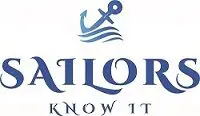
Boat Navigation In Fog (Safety rules to follow)
Being lost in the fog is frightening, but there are some things you can do to protect yourself. If you have a GPS or navigation chart with compass readings, use these tools to find your location. If you are not sure about your location or where you are going, it’s best to stop boat navigation until the fog clears up.
Many boat owners install fog horns on their boats to help other boaters locate them. If you have a boat horn, use it to signal your boat’s location to other boaters.
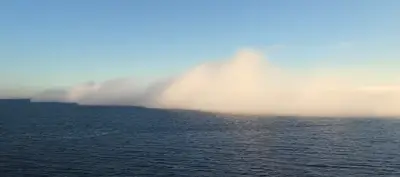
Boat Navigation In Fog – Boating In Fog Safety Tips
Let’s have a look at some navigation rules & tips.
When you’re setting sail, it’s important to have all your boat equipment on board. That includes a GPS, compass, horn, and safety gear. But there are other things that will keep you safe too.
Also, listen to the weather forecast before you set out so you can avoid unexpected navigation challenges like being caught in the fog.
Reduce speed
If you’re out on the water in foggy conditions, there are a few things that will help keep your boat safe. First, reduce speed as much as possible and take your boat out of the channel if there is any doubt about where you should be going. If you come across another boat, stay away from it to avoid a collision. Always ensure you are maintaining a safe speed for your boat.
Turn Light on
Boating safety is important, and one of the most common ways to stay safe on the water is by making sure your boat lights are turned on. When you’re out at sea and visibility drops with a foggy horizon, it’s easy for boats to run into each other without realizing they were there. To avoid this from happening, make yourself as visible as possible by turning on your running lights so that others can see where you are.
Navigational equipment
Make sure you have the appropriate navigational equipment for your boat. That includes a GPS, radar, and all of the other gadgets that help you stay on track when traveling in foggy conditions.
We also suggest checking over any safety equipment like life jackets or signal lights. Don’t forget about things like flares and whistles either. If something goes wrong out there, it might be difficult to get back home without these tools at hand.
Anchor your boat
If you want to avoid a collision, it is important that your boat follows safety guidelines. One of the most common mistakes boaters make in low visibility conditions such as fog or rain is not stopping their engines while they are on the water.
If you’re in a FOG and there is high traffic, stop the movement of your vessel. For better visibility to other boats on the water, it may be best to drop anchor and wait for all traffic to pass before continuing on your way. Boating safety depends largely on common sense, use yours.
Know Fog Sound Signals
Navigating in foggy conditions can be tricky. If you’re a powerboat operator, the International Regulations for Preventing Collisions at Sea provide a set of sound signals to help others understand where your boat is and what it’s doing–whether underway or drifting.
If your ship is drifting, always give two blasts of the horn for a boat underway. When you are at anchor, sound one short – one prolong – one short blast.
- Short blast – 1 second
- Long blast – 4 to 6 seconds
Take care of electronics
So, if you’re a seafaring person and spend lots of time on the water, we recommend equipping your boat with radar. It will give you an edge in foggy situations and provide safety for all aboard. Radar is a great investment for safety and peace of mind when on the water.
You may also consider adding other electronics such as GPS/Chart plotters, VHF radios, AIS receivers, etc., depending on how much navigation assistance you want from your vessel. The point being – don’t forget about the power of electricity.
Post a lookout
Safety is important for everyone on board, but it becomes even more crucial when there’s a fog. This means that the crew has to be extra vigilant and focused at all times if they want to avoid accidents. The best way to ensure this happens? Assign different areas of your boat (fore, aft, port, and starboard) so you can maintain a lookout at all times with the help of your crew members.
Navigating in the fog is a challenging problem for any boater, but it becomes especially dangerous when you have to rely on your own eyesight. There are some steps you can take in order to make foggy conditions easier and safer for yourself or your crew. One of the most important things you should do is carry a VHF radio with you at all times.
The Radio station will warn about areas where there may be a danger that’s not visible from the outside, such as rocks or other boats in close proximity to yours. Never forget to switch on your VHF radio.
Leave a Comment Cancel reply
Save my name, email, and website in this browser for the next time I comment.
- How to sail and navigate through fog safely
Fog at sea can be far more treacherous than rough conditions with high winds and large waves, particularly for smaller vessels. Visibility may be almost zero, increasing the risk of colliding with other boats, the shore, or other obstacles. If fog draws in at sea, your first priority should be to ensure the safety of your crew, start using appropriate signals and take steps to make your boat as visible as possible.
Orientate yourself in fog using all your senses
Poor or near-zero visibility may be the main concern when navigating in fog , but it is not the only challenge for the crew. Fog also distorts and dampens sound, causing it to reflect and travel in unusual ways which can make it difficult to determine which direction a sound is coming from. Even with sophisticated technology like navigation, GPS, and radar, it is possible to lose track of a boat's position and its heading in foggy conditions.
But that doesn't mean that sailing in fog is impossible. It just places significantly greater demands on the sailors and their experience and ability. In general, if the fog is close to shore and you are not sure if it will clear at sea, it is worth postponing departure from the marina or anchorage. If you are caught by fog at sea , several steps should be taken to maintain safety and minimize potential damage, based on sailing regulations as well as the expertise of experienced mariners.
The first steps to take when the fog starts rolling in
Avoid sailing in fog if you can, especially if sailing is more of a leisure activity for you and you haven't logged thousands of nautical miles. This means watching the weather forecast before setting sail and, if necessary, using your experience to judge whether fog is likely to develop during your trip. If there is already fog in port, it is better to wait until it clears so you can enjoy the beauty of sailing unhindered.
Out at sea, however, fog can easily catch you off guard and if this happens, you must act quickly. The safety of the crew comes first. All members should be fully-clothed and wearing life jackets, because, in the event of a collision, there may be no time to get dressed. Crew members should be secured to the boat using safety lines or harnesses that are loose enough to allow movement around the boat and easy to undo. Safety harnesses are essential because if someone falls overboard in fog, it will be near impossible to find them in the sea.
YACHTING.COM TIP: Do you know how to rescue a person who has fallen overboard? Despite all safeguards, sometimes it is unavoidable, so every crew member should know exactly what to do. Go over the main guidelines and steps to take in our article — Man Over Board (MOB): a step-by-step guide .
Turn on the radar reflector and navigation lights so the boat can be seen in the fog
As well as ensuring the safety of the crew, it is also crucial to focus on the boat itself and minimise the risk of collision . The moment fog sets in, the skipper or navigator should plot the boat's position as precisely as possible on the chart or determine its most likely position. The radar reflector should be switched on. If it is not fixed on the boat, place it as high as possible on the rigging. As the vast majority of vessels on the open sea use radar to avoid a collision, this will increase the chances of being noticed by a passing vessel. Next, turn on your navigation lights.
Don't forget to sound signals in fog
It is not just enough to improve the visibility of your boat; you also need to sound the signals prescribed by international law.
These are the usual sound signals in fog:
Under sail: one long and two short blasts every 2 minutes
Under engine power: two long blasts every 2 minutes
Unmanageable vessel, vessel with restricted movement: one long tone and two short blasts every two minutes
At anchor: ring the bell rapidly for 5 seconds every minute (one short, one long and one short ring)
More sailing tips:
Medicanes in Greece
The ultimate yacht cleaning kit
New Year's resolution: let's sail more eco
How to have a nautical Christmas
What to pack for a tropical sailing
How to gear up for the 2024 sailing season
Use your eyes.
Even though visibility is greatly reduced in foggy conditions, it is still important to keep a watchful eye on the situation rather than relying solely on radar and navigation systems. The ideal place to be is out on the deck, where the glass in the windows and the glow of the monitors won't impair your view. Depending on the type of fog, visibility is usually best at the surface or at height.
Don't be afraid to move around the deck to find the best vantage point with the best visibility. At least one crew member should be monitoring the situation, ideally more, and another person should be assigned to the radar to keep an eye on it constantly. If you are sailing in fog at night , you can further improve the visibility of the boat by shining or flashing lights onto the sails using a powerful flashlight.
YACHTING.COM TIP: Are you concerned about encountering foggy conditions at sea and don't have enough experience sailing in more demanding conditions? Rent one of our charter boats along with an experienced skipper and enjoy a stress-free sailing holiday. Our sales team will be happy to help you with both.
Get to know fog with your ears
Fog not only reduces overall visibility, it also distorts the way sound travels . A sound can easily be perceived as coming from a short distance ahead when in reality it is a warning signal coming from far behind you. This is why it pays to use all of your senses as well as the available technology to navigate through the fog and reach safe waters.
Hearing is an important sense when navigating fog, especially when combined with sailing know-how. One proven strategy adopted by experienced sailors is setting an appropriate course . Generally, sound carries downwind so if you're heading upwind, you have a better chance of hearing any sound signals ahead of you. Conversely, if you are travelling downwind, the sound will carry with you, making it much harder to detect and identify its source.
If you are not travelling under sail but using engine power , aim to cruise at a slower speed of around 3 to 5 knots (depending on the conditions). This means the engine will not drown out surrounding sounds. Turn off the engine every now and again and listen for any sounds or signals. In some cases, sound may get lost even when just two people are talking. It is therefore important to keep your ears open and monitor the situation closely. Of course, it is essential you know the fog sound signals described above, as well as the signals emitted by the neighbouring buoys, lighthouses and other marked sites, in order to navigate safely and prevent a collision.
YACHTING.COM TIP: Lighthouses are extremely useful when sailing in foggy conditions. Did you know that each has its own specific sound and light signals? Plus, they are real architectural gems, so take a look at our article on the 15 beautiful lighthouses you must visit .
Feel your surroundings with your whole body
To some extent, even your sense of touch or the sensations on your skin can assist you to navigate fog. And, while this is more of a supplementary aid when trying to get to a port or anchorage safely, every little thing counts.
Keep in mind that fog is caused by significant differences between air and sea/land temperatures . Therefore, you should head for a place where these differences are not so marked. Focus on how the air feels on your skin . For example, if the air feels warm while the water is cold, head for shallower waters where the sea is likely to be warmer and closer to the air temperature. Conversely, if the air is cool, head for the open sea where there is more depth and the water is cooler. 10–15
Don't forget your sense of smell
Even if you can't see or hear anything, smells may tell you a lot about what's going on around you. Smell is a complementary sense that can help you pinpoint the location of something that does not produce a sound. For example, the smell of fish can indicate the proximity of a fishing boat, just like diesel fumes can indicate the presence of a motorboat or boat nearby, etc.
YACHTING.COM TIP: Wondering what type of signals to use when sailing in fog? Sign up for a sailing course with us and learn everything you need to know under experienced professionals.
Need a skipper's license or just some more practice? Try our sailing courses...
Electronics and modern technology on board.
Most boats nowadays are equipped with modern navigation systems and equipment , (such as radar, GPS, radio, etc.) that pinpoint your current position and the position of vessels or obstacles around you. Electronics on board are of a very high standard, but they are not omnipotent. So, always consider electronics as an aid and a reference point, rather than the absolute truth.
Onboard radar system monitors for potential obstacles and other vessels
The moment fog rolls in, you should immediately turn on the radar . If you do not have it permanently installed on your boat, place it as far up on the rigging as possible to maximise its range. One crew member should be assigned to constantly monitor the radar and report to the helmsman or skipper about the presence of other vessels or hazards. Communication should be brief and to the point so that the helmsman can remain focussed on what they can see and hear around them.
GPS will help you to navigate your yacht
GPS is now the standard method of finding your location and searching for routes, even on smartphones, so it's no surprise that it's also an essential piece of equipment on a boat . However, like other electronic systems, GPS can be incorrect or inaccurate, especially when determining precise position or speed. Therefore, always use GPS in combination with your own observations . If you have a choice, go a GPS system that allows you to see where you had previously been sailing. When sailing in fog, this can be a useful way of finding your way back. Simply sail back in the opposite direction along your original course.
Radio can provide other useful information
An onboard radio is standard on most boats and is a useful aid when sailing in fog . If you have access to all the data you need, you can use the radio to communicate your position and intentions to nearby boats. This usually includes the name of the ship, its type and size, position (latitude and longitude), course and speed. To avoid any misunderstandings or distractions to you or other boats, always use simple and clear sentences in radio communication.
Now all that's left to do is pick a boat:
We have a large selection of boats available, as well as contacts with excellent skippers. Get in contact.

Denisa Nguyenová
Faq how to sail in fog.
- Yachting World
- Digital Edition

Sailing in fog: Pro navigator Mike Broughton shares his top tips
- November 26, 2020
Just a few minutes of sailing in dense fog takes most sailors well out of their comfort zones: it’s disorientating and, quite frankly, scary for many. Here are some tips on how to prepare for, and deal with, a ‘pea soup’

Sailing in fog can be exhausting and disorientating. Photo: Carlo Borlenghi
At sea, fog can be summed up as condensed water vapour or just thick cloud on the surface. Sea fog, or advection fog, forms when relatively warm moist air moves over colder water and cools to its dew point temperature, causing the air to saturate.
Unlike land fog, or radiation fog, sea fog can occur at any time of day and still exist with quite strong winds. It only really clears with a change of air mass – usually with the passage of a cold front. Without the passage of a cold front, it can last for days.
While radiation fog usually occurs on cold, still winter days, sea fog or advection fog is more prevalent in early summer. June can be a particularly bad month in the English Channel , when the water is still relatively cold, with warm moist air coming up from the south-west.

These Sat24.com website images reveal that what appears to be cloud in the satellite view…
Looking out for the forecasts of fog is important, but one simple trick is to go online and use satellite imagery. Sat24.com is a great website to see the last three hours of visual imagery, where fog often shows as a dull, grey and featureless cloud. Next, do a quick comparison with the infra-red satellite imagery and the fog seems to miraculously disappear, whereas other clouds tops still show up.
This is due to the fog being approximately the same temperature as the sea, hence giving a neat confirmation of the existence of fog on the visual picture. You can then return to the visual imagery and more accurately plot the extent of the fog and potentially take avoiding action.
Caught in fog
If you unexpectedly end up sailing in fog, first consider whether you need to keep heading further into it? Would it make more sense to do a quick 180° turn and head back out into clearer visibility?

…is in fact fog that disappears in the infrared view as shown here in the Celtic Sea and North Atlantic
Once we realise we’re sailing in fog, we need to work through a checklist of actions. Note your compass heading. Do we need a more experienced helmsman? It’s easy to quickly find you’re 30° or 40° off course and not notice. Steering is more exacting and even exhausting.
Could it be less stressful to use the autopilot , to allow you to focus on lookout? Just be ready to immediately switch to manual if you need to at a moment’s notice.
Slowing down is certainly good seamanship and the requirement to proceed at a safe speed appropriate to the conditions is detailed clearly in the International Regulations for the Prevention of Collision at Sea (IRPCS Rule 6 – Safe Speed).
Article continues below…

Weather expert Chris Tibbs on how to predict and cope with fog at sea
Radar and AIS help to make navigating in fog safer, but it is still an unnerving experience to sail in…

Navigation briefing: Mike Broughton explains why you still need radar
In a recent feature in Yachting World, my friend and highly respected yachting journalist Ed Gorman wrote a revealing article…
With an increased risk of collision, it’s good practise to ensure everyone is wearing a lifejacket . Maintaining a proper lookout is essential. In ‘pea soup’ fog, stationing a person forwards near the bow can help enormously. If motoring, the bow is a good place to escape the noise to allow the lookout crew member to listen for fog signals, or other hazards. On several occasions when I’ve been sailing in fog, the lookout at the bow has provided vital information to avoid a hazard or navigation mark.
In areas of dense shipping, remember to look up as well as straight ahead, I’m sure I am not the only person to have sighted a large vessel from the helm at the angle of the first spreader!
When ‘in or near areas of restricted visibility’ IRPCS states we shall make the prescribed sound signal, which for sailing vessels is one long blast, followed by two short blasts at intervals not more than two minutes. We need to have a working knowledge of sound signals of other vessels: many don’t appreciate that the fog signal for yachts is the same as vessels involved with fishing, towing, and even vessels ‘constrained by draught’ and ‘not under command’.
Make yourself visible
To help other ships see us, our best chance is to ensure we are clearly seen by the equipment on the bridge, which is radar and AIS (automated information system). Radar is a great help, but not all yachts have it, and it does take concerted focus and an understanding of how best to use it. Nearly all yachts have radar reflectors. Disappointingly tests have shown radar reflectors are not as effective at enhancing our radar signature as many people think. Active radar transponders show up much better.
AIS has been a real step change to aid collision avoidance when sailing in fog, though always remember that not all vessels use it and it is only an aid, albeit a very useful one. AIS can give the speed and course of a vessel as well as the closest point of approach (CPA) and time to the CPA: this is really useful data when navigating in fog. AIS also gives the vessel name, call sign, type and size.
Navigation lights are essential in foggy conditions. In a really thick fog the bow navigation lights can reflect back off the fog, leaving you with an eerie red or green glow.

Do you know how to make the prescribed sound signal in restricted visibility?
The amount of radio traffic tends to rise when sailing in fog, though beware using VHF radio to communicate with the watch keeper of another vessel, which can be fraught with problems.
There have been at least three occasions in the Dover Straits where watch keepers have opted to use radio to try to negotiate collision avoidance, which has ended unhappily in a collision!
These have often come about through misidentification and language difficulties, when both watch keepers should have prioritised normal rules of the road and not allowed themselves to be distracted in an important close quarters situation.
One tactic for dealing with fog on small vessels is to head away from busy shipping channels and sail to shallow water and anchor. Once tethered to the seabed remember to sound your fog signal (for vessels over 12m, ringing a bell for five seconds every minute). Many sailors may not be familiar with the additional signal of one short, one long, one short blast that can be made after the bell if you are concerned of a risk of collision while you are an anchor.
Stopping and racing in fog
Racing in fog creates extra challenges. Fog by night can take you by surprise and it is easy to lose hard fought gains, if the helmsperson loses awareness. If you have the choice of tacking into fog or not when racing, I would take the clear option every time: humans concentrate better when they can see.
The disorientation and confusion that sailing fog can create can easily generate high levels of stress. Mat Sweetman, captain of the J Class yacht Rainbow , suggests: “It is easy to get freaked out in fog, [but] look at is as if it was just a dark night and it gets a whole load less stressful.”
One clue as to the existence of fog at night is an absence of ambient lights and low altitude stars. If you are on the helm and getting close to fog, it is a good idea to start a scan of your yacht instruments. Like a pilot flying into cloud, it is imperative to ‘believe in your instruments’.
A regular scan is most effective but is both tiring and exacting over a long period of time. On top of normal sailing skills such as utilising the feel of your helm, tell tales (if you can still see them) and heel angle, we now need to bring in regular glances at true wind angle, boat speed, and heading. Working out a pattern for your scan is a good discipline for sailing in fog.
Sea fog is renowned over the Grand Banks. On the Transatlantic Race in 2005, fog prevailed for over six days with sustained wind speeds of 25-30 knots. Visibility was mostly less than 150 metres. Sailing in fog for nearly a week is tough going!
Using radar for collision avoidance
- Periodically cycle through the ranges and don’t leave it just on long range. Zoom in to only three miles in busy shipping and even closer when tracking a vessel of interest.
- Leave the sensitivity and clutter settings on auto. Modern radars handle them well.
- If you want to look through a rain cloud, alter ‘rain clutter’ control very briefly, then revert it to automatic every time.
- Use a split screen with radar on dual range, or radar and chartplotter lined up alongside, or radar ‘overlaid’ on the chartplotter.
- Experiment with this before you hit fog.
- Consider setting up an alarm zone to help you detect contacts.
- If your radar display is below decks, have a tested system for communicating to the helm. Some yachts use a private VHF channel.
- Stay clear of busy ferry routes
First published in the November 2020 issue of Yachting World.
Sailing In The Fog – What You Need To Know And Do
Ben Eriksen Carey July 15, 2014 Words 1 Comment
Sound Signals and VHF Protocol in the Fog
Our recent 3 day Morse Alpha sail training expedition in beautiful Maine offered a wide variety of sailing conditions. We saw gusts to 30 knots the first day out, thick fog the second, and light winds the third. The perfect course… a little bit of everything, couldn’t have planned it better myself.
We had fun tucking in a 2nd reef, then a 3rd, then shaking them all, and re-tucking them! We experimented with balance, moving our center of effort forward then aft to feel the effects of each sail individually.
But when the fog rolled in overnight, and the southeasterly winds persisted the next morning, we knew we weren’t going to be able to avoid traveling in the fog. We delayed as much as possible, spending time below going over sail theory, sail trim and learning the nuts and bolts of navigation in the fog. But 1100 came, and we had to catch the tide.
The Scenario
We conservatively motored our way through the Casco Passage, a tight channel with a strong 2-3 knot current and about a thousand lobster traps, or so it seemed—we were too busy to count. Making our way west towards The Deer Island Thorofare we heard the schooner Mary Day on the VHF giving a securité (pronounced “secure-a-tay”) call, announcing their name, location, direction of travel, and that they were under sail. They were just making their way past Stonington, eastbound. It was obviously socked in there too, bad news.
A sailing vessel replied to their securité call and asked for clarification on the Mary Day’s direction of travel and exact location (on a working channel, NOT 16). Then went on to ask how thick the fog was there. Captain Barry let him know he was “ socked-in just north of Russ Island “. To which the sailboat replied, “D o you think I should drop anchor here, right where I am if it’s really thick there?”
“Well Cap, I can’t really say. That’s up to you to decide.” Barry responded.
“Well, I think I’ll keep going then.” the yachtsman stated.
“Just keep sounding your horn, and we should pass each other safely” said Barry.
“We don’t have a horn.”
“Oh. Well Cap, that’s not good” said Barry calmly, surely holding back a few expletives and his opinion of the yachtsman’s seamanship on this public VHF forum.
A Sound Solution
As a sailing vessel with an auxiliary engine, we are required, under normal circumstances, to sound one of two (we are either a sailing vessel or a power-driven vessel) different sound signals in the fog as started clearly by Rule 35. It’s not an option! And besides, we kinda like to toot our horn!
Rule 35 – Sound Signals in Restricted Visibility (view full rule)
(a) A power-driven vessel making way through the water shall sound at intervals of not more than 2 minutes one prolonged blast. (—)
(c) A vessel not under command , a vessel restricted in her ability to maneuver whether underway or at anchor , a vessel constrained by her draft , a sailing vessel , a vessel engaged in fishing whether underway or at anchor and a vessel engaged in towing or pushing another vessel shall, instead of the signals prescribed in paragraph (a) or (b) of this Rule, sound at intervals of not more than 2 minutes three blasts in succession, namely one prolonged followed by two short blasts. (— • •)
*note: prolonged = 4-6 seconds, short = 1 second.
A Radio Solution
All vessels are allowed to give securité calls on the VHF, you don’t have to be large or restricted in your ability to maneuver. Securité calls are preferably made on channel 13, but unfortunately not everyone monitors 13. So channel 16 is used frequently. Please monitor channel 13! As a recreational vessel, we exercise diligence when giving securité calls, trying to reserve their use to narrow channels, busy commercial lanes, or when radar targets of concern are within a mile or two. But if there is ever doubt, we get on the radio and broadcast a securité.
How To Give An Effective Securité Call
Securité, Securité, Securité.
This is the forty-four foot sailing vessel Rocinante .
We are motor-sailing eastbound through the Fox Island Thorofare, just passing red nun number ten, off Iron Point.
Any concerned traffic please respond on channel one-three or one-six.
This is the sailing vessel Rocinante standing by on one-three and one-six.
The Prudent Solution
But no matter what we decide to do, underlying many of the decisions we make aboard Rocinante is the desire to be able to explain our actions in a court of law. We often ask ourselves, if an accident were to happen, would we be able to justify our every action and prove that we acted in the most prudent, responsible manner, and maintained the highest standards of seamanship. This may seem like a fearful way of living and sailing, but we don’t see it that way. Rather, it provides a very clear guideline for making decisions. If our yachtsman in the conversation above were to have had a collision with the Mary Da y, surely his lack of a horn would not hold up well in court. A very simple, inexpensive piece of gear could cost him his entire vessel (insurance payout).
Very timely! I am getting ready to head out today and I anticipate fog all weekend here in the Puget Sound. Your article was a good refresher for me. I just finished mounting and wiring my horn yesterday!
Leave a Reply Cancel reply
Your email address will not be published. Required fields are marked *

Sound Signals for Vessels
The basic sound signals you should know are shown below. This information is embedded in the NauticEd Skipper Course and the NauticEd RYA Day Skipper Course.
Also, download our Navigation Rules eBook for iPad where the complete set of Navigation Rules are given and explained with animations – ONLY $2.99.
Tap each image to hear an example sound.
Between each successive signal you should wait 10 seconds or more.
These sounds are to made by power-driven vessels greater than 12 meters (39ft) in length and when operating in a narrow channel and have sighted each other.
The danger signal is general and can be used by anyone to signal disagreement with another vessel’s signal, which may lead to danger or just danger in general to anyone.
Sailboat in Fog
When operating in areas of restricted visibility IE fog, a Sailboat must make the following signal.
Remember this by an average sailboat normally has two sails- thus the two shorts toots.
Powerboat if Fog
Where prolonged is a prolonged blast (lasting 4 to 6 seconds) and signals are not more than 2 minutes apart. This signal above (one prolonged and two short) is also the signal for other vessels operating in fog such as vessels towing, broken down, commercial fishing, or restricted in ability to maneuver.
Power driven vessels operating in fog must make the following signal not more than 2 minutes apart.
These are international rules. The above list of signals is not exhaustive. For a list of all sound signals visit Rules 32 through 37 of the USCG regs (which again are international).
Finally, a piece of advice: Make sure you have a loud sound making device at hand at all times near the helm available with in 1-2 seconds. The day you will need it is the day you will thank yourself for heeding this advice.
Oh and BTW, that day WILL come – read this story about how it was too late
- Recent Posts
- Sea of Cortez Flotilla – February 2025 - March 8, 2024
- British Virgin Islands Flotilla – March 2025 - March 2, 2024
- Sail on the Clipper Stad Amsterdam - January 26, 2024
You might also like
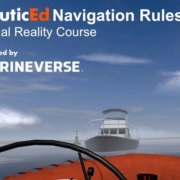
TWEET ABOUT

FIGHT CHILDHOOD CANCER
NauticEd is a fully recognized education and certification platform for sailing students combining online and on-the-water real instruction ( and now VR ). NauticEd offers +24 online courses , a free sailor's toolkit that includes 2 free courses, and six ranks of certification – all integrated into NauticEd’s proprietary platform. The USCG and NASBLA recognize NauticEd as having met the established American National Standards. Learn more at www.nauticed.org .

The NauticEd Vacations team are Expert Global Yacht Charter Agents – when you book a sailing vacation or bareboat charter through NauticEd, we don’t charge you a fee – we often save you money since we can compare prices from all yacht charter companies. PLUS, we can give you advice on which destination or charter company will suit your needs best. Inquire about a Sailing Vacation or Charter .
Online Sailing Courses Sailing Vacations | Charters Practical Sailing Courses Sailing Certification | License
Sign up for 2 FREE Sailing Courses Try sailing in Virtual Reality! Gift a Friend a Sailing Course Sailing Events | Opportunities
About NauticEd Contact Us NauticEd Support Privacy Policy
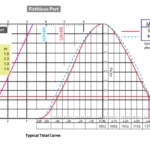

How To Sail Through Fog (Don't Forget To Enjoy It)

Last Updated by
Capt Chris German
June 15, 2022
Sailing is the art of using the wind to move slowly at great expense. That act becomes substantially less satisfying, when hampered with reduced visibility.
Sailing in fog, darkness, or any other reduced visibility can bring a myriad of terrors from navigational hazards, other boats, and even the wind itself.
You rely on your sense of sight so completely with a sailboat, that when that sense is reduced, your ability to purposefully sail in one direction becomes more of a desperate act of mere survival.
Reduced visibility is a hazard aboard any sea going vessel. The International set of rules agreed upon by every maritime-based nation in the history of the world has as it’s cornerstone the imperative that all skippers must maintain 360 degrees of visibility at all times.
If you can’t see on a boat, you are by definition “in danger.” The fact that you are in fog and darkness by its very nature is dangerous and to do so can be incredibly scary. But sailing in fog particularly sucks.
Darkness, precipitation and fog all present a substantial danger to the sailor by the fact that those conditions reduce visibility.
Couple any of those conditions with the intrinsic features of a sailboat (IE. reduced maneuverability of a sailboat, the construction of most sailing craft including integral equipment below the waterline such as the rudder, keel and propeller, and the fact that all of this activity produces the sound of cash being flushed down the toilet) and the act of going to the sea in boats in reduced visibility becomes a very distasteful premise.
So I say again, sailing in fog sucks.
Table of contents
Fog Affects Visibility
Fog is different from mere darkness or precipitation. Darkness can be mitigated with aids to navigation and modern conveniences like gps and radar.
Sailing on a starry night while a bit nerve racking at times, can also be a magical experience for the well prepared skipper. The calming effect of nightfall on the sea can create a glass-like surface on the water and often enough, a sailboat can slide silently beneath the heavens and offer a cathartic escape from the temporal world in the evening hours.
At the very least, nightfall means relief from the heat of a dispassionate sun. But the wind and its indicators, rarely disappear entirely in times of darkness or precipitation. But in fog, the wind becomes an enigma.
The fact that you can’t see the waves, landmarks or flags and many times, can’t even see your windex at the top of your mast, means you are entirely dependent upon apparent wind.
Your sense of the true wind is eradicated in fog.
True wind is the wind as it comes from God’s perspective - the wind just as Mother Nature intended.
Apparent wind is a figment of your imagination. It’s the wind as affected by the movement of your boat and as it appears to you the sailor. So when my sense of true wind is diminished, I get nervous and start making bad decisions.
Many times with fog, the wind drops off entirely and your boat drifts at the mercy of the current.
A Brief Example
I have been floating down Long Island Sound in late spring when fog rolls in, and drifted for 20 miles without an ounce of control.
We were sailing to Block Island from Stamford one weekend in May aboard a 40 foot Tartan named “Green Hornet” some 20 years ago.
We started the race with a warm 10 knots blowing on our nose at 5 pm on Friday and we beat to windward with the following tide.
By midnight we were off New Haven with a cold drizzle falling on our decks leading a pack of a few dozen boats in our wake.
By Saturday morning we could see the cornered cliffs of Block Island and were having a great time, giving us hope that we would take first in the race by late Saturday night.
Screaming around Block and making a steady 8 knots as we passed New London at noon on Saturday, an air of celebration took over the boat as we set a full spinnaker for the downwind run to home.
But by sunset Saturday, the wind dropped off entirely and a thick blanket of fog wrapped our boat tightly, ten miles off New Haven Harbor.
For the next six hours we did all we could to hold position and not be dragged back to Montauk Point on the outgoing tide.
That entire night we sat blind and drifting, hearing the wail of the fog horn at New Haven Harbor, taunting us for our hubris assumption that we would be home on time.
A turn of the tide and a slight shift of the wind reversed our drift towards home and by 5 PM, Sundy the cannon blew and we knew we had made it, taking honors and winning bragging rights.
But just as we crossed the finish line, a US Coast Guard Patrol flashed their lights and chirped for all to hear on the PA system, “Chris German, Call your Mother.”
Apparently no one told my mother that in a sailboat race you can’t turn on your motor, and when we weren’t back Saturday afternoon, she began calling every Coast Guard station from Boston to Cape May looking for me. Sailing in Fog sucks.
Fog Affects Sound
It’s not just the wind that plays tricks in the fog. Sound itself is morphed into strange beasts when your eyes are removed from the sailing equation.
In fog, sound bounces off the water particles in the air and the stillness amplifies those sounds so that the rumble of a boat motor five miles away may sound like five feet to the sight-starved ears of a wayward watch stander.
Water lapping at a rock pile takes on the appearance of an impending tsunami when the heightened awareness and nerves of fog set in.
And nothing sets a chill to the spine like the sound of an unexpected gong, horn or worst all, bell in a fog bank.
The Gong oftentimes is a safe water mark or perhaps a huge tanker at anchor. The fact that it is unexpected is bad, but if it is a gong you hear, you know you are at least in deep water.
If it’s a horn you hear, you are nervous because it could be a boat underway or not, fishing or not, sailing or not.
You really should know your fog signals but who really does these days? All you really know is there is another boat or ATON nearby and a risk of collision may exist.
But the worst of all in fog is the bell. Particularly three short, one prolonged ring followed by three more short.
If you hear that in Fog, then it’s time to panic because you are near another boat who has the sense to use fog signals, but has lacked the sense to avoid going aground and you’re next to them.
In truth I have only had to use fog signals once in my career. I was in Bridgeport, CT in my 34 foot Cal that I had just purchased and was teaching a lesson.
I had four adults on board and really had just launched the boat without fully checking all the safety gear. I had to go out, because I had paying passengers, but as it is so often when the water is still cold in Long Island Sound and the warm moist air of Spring sets in, so to came the fog.
We reached the end of the channel and found ourselves in a white haze of late morning fog just off Penfield Reef light in Black Rock Harbor.
We couldn't see much at all but knew that the harbor was quite busy this time of year and the chances of a big old stinkpot running over our little sailboat were quite good.
Looking below, I found the only noisemaker the previous owner had left for me, a horn, much like those that are used at the soccer games of Europe.
Lucky enough for me, one the students on board was the tuba player for the Bridgeport Symphonic Orchestra and he had a unique gift for both keeping time and blowing long blasts on a horn.
For three hours he blew, “BWAAANNNNNHHHHH, BWAHN BWANH” every two minutes like machine. He impressed the hell out of all of us on the boat and it was entirely to his credit that we avoided a collision from Joey Bagadonuts and his 32 foot gas hog.
Did I mention that sailing in fog sucks?
Fog Is Not Always The Same
Fog is not however the same everywhere, everytime.
In North Carolina, fog is common in the winter months in evenings and early mornings but a rarity for the other 10 months of the year.
While in New England, fog has so many more chances to form given the cold waters and comes in so many different shapes, colors and densities.
Fall River, Mass has some of the best fog I have ever sailed in because it comes like clouds floating in and out from Newport and up from the North Atlantic.
Boston’s fog reminds me of what it must be like in London and would be quite lovely if not for all the rock strewn islands dotting Boston Harbor.
And in Maine’s Fox Thoroughfare, the fog is persistent, moving in like the blob and sitting there for days.
I was a lighthouse keeper at the North Haven light for one summer, where people could rent the lighthouse for a week and live remotely in the middle of the water in a Spark Plug-style lighthouse.
One couple I dropped off experienced this fog just minutes after I dropped them off at the lighthouse.
And five days later when I returned to get them, they were on the verge of madness having listened to the fog horn morning, noon and night for five days straight with nothing to see but a milky fog bank the entire time. Imagine what it was to be a sailing ship in fog 100 years ago?
One of my favorite scenes in the movie “Master and Commander”, Captain Aubrey (played by Russel Crow) and his crew is set upon by the French Navy. The French Ship Acheron blasts away the rudder chains of the HMS Surprize in a close quarters battle and the Captain orders his crew to launch the long boats and row their stricken sailboat to the safety of a fog bank.
The Acheron knowing the dangers of fog doesn’t dare follow the brave, yet foolish Surprize into that fog and it is the French timidity that causes them to lose their pursuit of the Surprize.
The author illustrates perfectly the love-hate relationship a sailor has with fog and while it may be safe for one vessel, it is certain peril for the other.
How to Navigate Through Fog
Thankfully today we have so many more tools at our disposal to navigate in fog. Charts and GPS have diminished the treachery of fog, but in no way eliminated it.
And radar for vessels that might have it, has revolutionized the visible landscape where once we were traveled in complete blindness.
But fog with its trickery can tempt you to trust your senses over instruments. Don’t be tricked into thinking you know more than the Garmin.
The GPS is linked up with satellites a thousand miles up in space who have ways of seeing through fog where you can’t.
The Military spent billions developing those satellites and those systems and made it so precise that at one time they had to dumb it down so evil doers couldn’t use it for evil purposes.
But it’s spot on accurate if you believe in it, because it works only as well as the person or the boat on which you're using it.
If you start doubting your GPS when coming up a channel you can get yourself turned around and in trouble in a hurry.
GPS was not designed for sailboats, but rather missiles and fighter jets.
Sailboats are not that fast and sometimes even go backwards. This movement can make a gps go wonky and with the light winds of a fog bank, it can be incredibly unnerving and confusing.
If you have any questions about that, look how wacky google acts when you pull into a gas station or mini-mall. While GPS is better than anything else we have ever had in boating, it can go wild at inopportune times.
So for sailing purposes, gps is only one half of the navigational equation.
Paper Charts
Paper charts do what the gps can’t, so don’t be lulled into thinking GPS is the alpha and omega.
A GPS shows you the current picture of where you are. Depending on what your scale and what your settings might be, you can miss all sorts of things that the GPS doesn’t know to show you.
A chart on the other hand, shows you God’s perspective. The whole enchilada so to speak.
Suppose you’re making way to head along the coast of Connecticut to the Connecticut River. You might set a gps course that says go 260 true and never see that that course runs smack dab over Falkner Island on a GPS.
But examine that track on a chart and you will see every hazard along the way whether you are looking for them or not.
In this push to walk away from paper charts, I believe they are an invaluable partner to the gps if you know how to use them. You can plot your position on a chart and make estimates for where your next positions might be. You can get ancillary information about an area on a chart that turns to be mission critical.
Whereas on a GPS if you don’t know look for it, you’ll have a hell of time finding it. And when you begin to doubt yourself, a chart can be a great reality check.
I’m not saying I have (wink wink) but I know many-a-sailor has lost their bearings in a fog bank after a flubbed tack.
The boat spins aimlessly adrift and the gps gets totally turned around. A plotted position on the chart can bring you back to reality when both your head and your gps go haywire in a fog bank.
And it does happen to humans regularly, even if it's uncommon in the GPS.
The Positive Side of Sailing Through Fog
But for all the ire that is sailing in fog: The wacky wind, the sinister sounds and the “find-muck” that is sailing with compromised senses. Fog really is just clouds on the water. A collection of semi-liquid water vapor suspended between layers of the earth's atmosphere.
This one just happens to occur on the surface of the water and not in the upper troposphere. It is one of the coolest weather phenomena on the planet save for maybe roll clouds and thunder snow.
But generally speaking fog does not occur with cloud to ground lightning and you don’t have to shovel your driveway after a fog bank rolls through.
But sailing in fog is one of the few times that you can truly feel what it is like to be a bird. To silently streak along through the clouds using only the wind as your propulsion.
Pilots speak of mystical feelings when their motors stop and their planes turn into gliders. No rumble of the motor, just your wing flaps and the wind currents carrying you aloft or down to your death.
And that is what a sailboat really is, a glider turned sideways with one wing in the air and the other below the sea with virtually no chance that you will crash into the ground at 600 miles an hour.
Sailing is the closest some of us will ever get to the heavens. When the moon is full in Long Island Sound off the coast of my hometown in Stratford, CT and the tide is high, the water takes on a magical feel.
Swollen with salty water pulled by the moon's gravity and cold from the relatively high latitudes and proximity to the North Atlantic currents.
Fog forms readily when combined with the stillness of the slack high water and the warm evening air.
A sailboat will be lucky to find a breath of breeze on evenings like this, but that really doesn’t matter because the fog blows by you at an astounding pace as it races along the temperature gradients that form between the air and the water.
Your skin gets cool and clammy from the condensing water that coats your spars and sails and makes your decks wet and slippery.
It’s almost like taking a shower without water, just super drenched air that soaks your clothes and hair.
It is THIS time that being on a sailboat in fog is most amazing because you are taking part in a weather phenomenon that touches your soul and makes even the most ardent deity denyers question their beliefs in an almighty power.
Wrapping Things Up
Sailing in fog sucks, almost always. I've sailed the entire Eastern Seaboard and had more than a few bad experiences sailing into and out of fog.
The winds can crap out almost entirely in a proper fog bank, the sounds can make your skin crawl and the fog can screw with the mind of the most well grounded of skippers.
Given my choice between sailing in fog and not sailing in fog, I will always choose the latter because reduced visibility is just dangerous in all its many forms.
But only by sailing in fog can you enjoy some of the most amazing things that happen on the water in a boat.
Sailing in Fog is a chance to fly with the Gods and tap into the mystical rhythms of the natural world.
Sure you’ll get there faster in a power boat and you can sneak up on stuff better in a kayak, but only by harnessing the natural forces of wind and waves can you truly become part of the atmosphere when you sail in the fog.
It’s not something I would recommend if you can avoid it, but if you can’t avoid it, you might as well enjoy it.
Be safe out there and sail far.
Related Articles
Capt Chris German is a life long sailor and licensed captain who has taught thousands to sail over the last 20 years. In 2007, he founded a US Sailing-based community sailing school in Bridgeport, CT for inner city youth and families. When Hurricane Sandy forced him to abandon those efforts, he moved to North Carolina where he set out to share this love for broadcasting and sailing with a growing web-based television audience through The Charted Life Television Network.
by this author
How to Sail
Most Recent

What Does "Sailing By The Lee" Mean?
Daniel Wade
October 3, 2023

The Best Sailing Schools And Programs: Reviews & Ratings
September 26, 2023
Important Legal Info
Lifeofsailing.com is a participant in the Amazon Services LLC Associates Program, an affiliate advertising program designed to provide a means for sites to earn advertising fees by advertising and linking to Amazon. This site also participates in other affiliate programs and is compensated for referring traffic and business to these companies.
Similar Posts

How To Choose The Right Sailing Instructor
August 16, 2023

How To Sail From California To Tahiti
July 4, 2023

How To Tow A Skier Behind A Boat
May 24, 2023
Popular Posts

Best Liveaboard Catamaran Sailboats
December 28, 2023

Can a Novice Sail Around the World?
Elizabeth O'Malley

4 Best Electric Outboard Motors

How Long Did It Take The Vikings To Sail To England?

10 Best Sailboat Brands (And Why)
December 20, 2023

7 Best Places To Liveaboard A Sailboat
Get the best sailing content.
Top Rated Posts
Lifeofsailing.com is a participant in the Amazon Services LLC Associates Program, an affiliate advertising program designed to provide a means for sites to earn advertising fees by advertising and linking to Amazon. This site also participates in other affiliate programs and is compensated for referring traffic and business to these companies. (866) 342-SAIL
© 2024 Life of Sailing Email: [email protected] Address: 11816 Inwood Rd #3024 Dallas, TX 75244 Disclaimer Privacy Policy

Service Locator
- Angler Endorsement
- Boat Towing Coverage
- Mechanical Breakdown
- Insurance Requirements in Mexico
- Agreed Hull Value
- Actual Cash Value
- Liability Only
- Insurance Payment Options
- Claims Information
- Towing Service Agreement
- Membership Plans
- Boat Show Tickets
- BoatUS Boats For Sale
- Membership Payment Options
- Consumer Affairs
- Boat Documentation Requirements
- Installation Instructions
- Shipping & Handling Information
- Contact Boat Lettering
- End User Agreement
- Frequently Asked Questions
- Vessel Documentation
- BoatUS Foundation
- Government Affairs
- Powercruisers
- Buying & Selling Advice
- Maintenance
- Tow Vehicles
- Make & Create
- Makeovers & Refitting
- Accessories
- Electronics
- Skills, Tips, Tools
- Spring Preparation
- Winterization
- Boaters’ Rights
- Environment & Clean Water
- Boat Safety
- Navigational Hazards
- Personal Safety
- Batteries & Onboard Power
- Motors, Engines, Propulsion
- Best Day on the Water
- Books & Movies
- Communication & Etiquette
- Contests & Sweepstakes
- Colleges & Tech Schools
- Food, Drink, Entertainment
- New To Boating
- Travel & Destinations
- Watersports
- Anchors & Anchoring
- Boat Handling
Boat Sound Signals: Time To Sound Off
Advertisement
When caught in a situation with restricted visibility, you'll need know how to let others know where you're located — and interpret where they are.
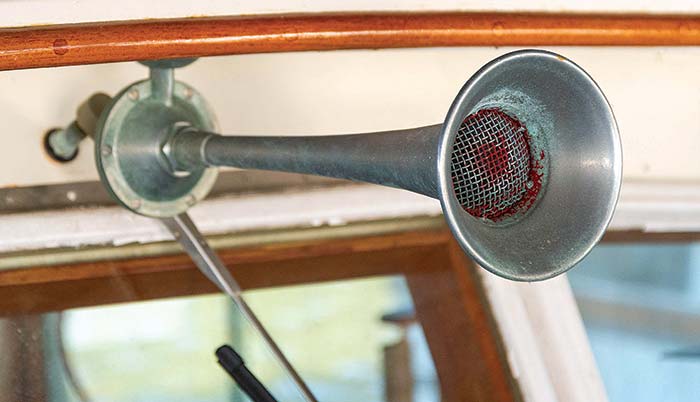
Photo: Stacey Nedrow-Wigmore
While the term "restricted visibility" may sound like there's something in your path that obstructs or blocks the view of where you're going, in maritime terms, it describes not only a situation where an operator can't see hazards in their path and around them, but also one that prevents your boat from being seen by others. Two common examples of this would be operating a vessel at night or during inclement weather. But restricted visibility can also occur due to unusual circumstances, such as dust storms or even smoke from nearby forest fires.
Boats need to be aware of each other's position at all times to operate safely, which is why adherence to navigational rules (such as the proper display of lights and use of sound signals) during periods of restricted visibility is so crucial.
Similar to the visual information provided by navigational lighting, sound signals provide an audible means of conveying your intentions, while also helping you understand what other boats around you are doing. This is especially important in situations of restricted visibility, such as fog, heavy rain, or when transiting areas where a vessel operator may experience limited visibility due to physical characteristics (a sharp bend in a narrow river, for example). In situations like these the effectiveness of navigation lights may be reduced or eliminated altogether.
Inland Vs. International
In some cases, the sound signals for International Rules may differ slightly from those described in the Inland Rules (the focus of this article). If traveling overseas, be sure to consult and familiarize yourself with the International Rules beforehand as provided in the Navigation Rules. While every boat owner should have sound-signal information on board for quick reference, a printed copy of the Navigation Rules is mandatory for vessels over 12 meters (39.4 feet) in length.
Sound-Producing Devices And Characteristics
Sound signals are described as "blasts," of which there are two types: A "short blast" means a blast of about 1 second, while a "prolonged blast" is 4 to 6 seconds.
The word "whistle" is defined in the Navigation Rules as any sound-signaling device capable of producing the required blasts as described by Annex III of the Rules. While Annex III provides the technical details of what constitutes a proper blast (such as frequencies and intensity) a simple interpretation for most recreational boaters would be how far the blast can be heard. For example, the minimum audibility range for a whistle or horn (both can be used interchangeably) required for a vessel 20 meters (65.6 feet), but less than 75 meters (246 feet) in length is 1 nautical mile. The minimum range for a vessel 12 meters (39.4 feet), but less than 20 meters is .5 nautical miles.
Most every vessel is required to carry some form of sound-producing device, and even those that are not would do well to have one on board, regardless of mandated carriage requirements.
That said, the Navigation Rules state a vessel 12 meters or more in length shall be provided with a whistle and a bell. Vessels of 100 meters or more in length shall additionally carry a gong, the tone and sound of which cannot be confused with that of the bell. The bell and gong may be replaced by equipment having the same respective sound characteristics, provided that manual sounding of the prescribed signals is always possible. An example of this would be an electronic loud hailer system that can generate the required sounds.
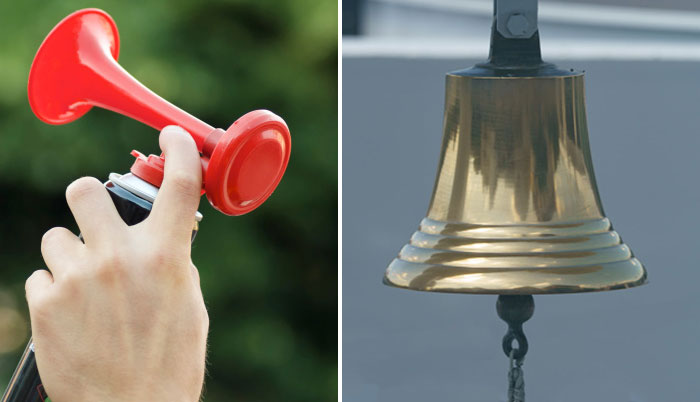
Acceptable sound-producing devices on board a boat can include an air horn, bell, or whistle, depending on the boat. (Photos: Air horn: Getty Images/gabrieletamborrelli; Bell: Getty Images/Yury Karamanenko)
Vessels less than 12 meters in length are required only to carry an "efficient" sound-producing device, such as a bell, air horn, or whistle. While banging on that galley pot may technically qualify as meeting the letter of the law, do yourself (and everyone else) a favor and carry an appropriate a sound-producing device. As the goal here is to be heard, ditch that wimpy horn and get one that makes the other boats think the Queen Mary is headed their way!
Sound Signals During Restricted Visibility
The below summary focuses on sound signals applicable for recreational vessels during restricted visibility. Keep in mind, however, that vessels engaged in other activities (towing, for example) will often have different or additional sound signal requirements and that sometimes variations may apply. When in doubt, always refer to the Navigation Rules .
- Power vessels making way through the water must sound one prolonged blast at not more than 2 minute intervals.
- A power vessel underway but stopped (not making way) must sound two prolonged blasts roughly 2 seconds apart at intervals of not more than 2 minutes.
- A sailing vessel, a vessel not under command, a vessel restricted in her ability to maneuver (whether underway or at anchor), or a vessel engaged in fishing (underway or at anchor) must sound three blasts in succession (one prolonged followed by two short blasts) at intervals of not more than 2 minutes.
- A vessel at anchor must ring a bell rapidly for about 5 seconds at intervals of not more than 1 minute apart. For vessels 100 meters or more in length (which require both a bell and gong), the bell shall be sounded in the forepart of the vessel and immediately after the ringing of the bell, the gong shall be sounded rapidly for about 5 seconds in the after part of the vessel. A vessel at anchor may, in addition, sound three blasts in succession; namely, one short, one prolonged and one short blast, to give warning of her position and of the possibility of collision to an approaching vessel. When anchored in a special anchorage area designated by the Secretary, vessels less than 20 meters in length, barges, canal boats, scows, or other nondescript craft are not required to give the sound signals described above for anchored vessels.
While vessels less than 12 meters in length are not required to give the above signals, they are required to make some type of efficient sound signal at intervals not more than 2 minutes apart. While there is leeway regarding sound signals for vessels less than 12 meters, why try to reinvent the wheel here? Having a proper sound-signaling device on smaller vessels and using the same sound signals (where practical and permitted by the rules) are a win-win for everyone on the water, in my opinion.
Finally, a vessel nearing a bend or an area of a channel or fairway where other vessels may be obscured by an intervening obstruction must sound one prolonged blast. This signal must be answered with a prolonged blast by any approaching vessel that may be within hearing around the bend or behind the intervening obstruction.
Remember these sound signal rules (we recommend carrying a cheat sheet on board), and you can cruise with the confidence of having added to your boating safety skill set.
Related Articles
The truth about ceramic coatings for boats.
Our editor investigates the marketing claims of consumer-grade ceramic coatings.
Fine-Tune Your Side Scan Fishfinder
Take your side-scanning fishfinder off auto mode, and you’ll be spotting your prey from afar in no time
DIY Boat Foam Decking
Closed-cell foam flooring helps make boating more comfortable. Here’s how to install it on your vessel
Click to explore related articles
Frank Lanier
Contributing Editor, BoatUS Magazine
Capt. Frank Lanier is a SAMS Accredited Marine Surveyor with more than 40 years of experience in the marine and diving industries. He’s also an author, public speaker, and multiple award-winning journalist whose articles on boat maintenance, repair, and seamanship appear regularly in numerous marine publications worldwide. He can be reached via his YouTube channel “Everything Boats with Capt. Frank Lanier” and website captfklanier.com.

BoatUS Magazine Is A Benefit Of BoatUS Membership
Membership Benefits Include:
Subscription to the print version of BoatUS Magazine
4% back on purchases from West Marine stores or online at WestMarine.com
Discounts on fuel, transient slips, repairs and more at over 1,200 businesses
Deals on cruises, charters, car rentals, hotel stays and more…
All for only $25/year!
We use cookies to enhance your visit to our website and to improve your experience. By continuing to use our website, you’re agreeing to our cookie policy.
Yachting Monthly
- Digital edition

How to avoid collisions in fog
- Andy Du Port
- April 8, 2020
Not many of us would happily set sail in fog but sometimes it is unavoidable, and knowing how to avoid collisions is crucial, says Andy du Port

Fog, even if it is localised, changes which navigation rules you follow. Would you know what to do?
Sir John Harvey-Jones, erstwhile chairman of ICI, once said, ‘Planning is an unnatural process; the nicest thing about not planning is that failure comes as a complete surprise rather than being preceded by a period of worry and doubt.’
When you see the fog rolling towards you, it is too late to start planning.
Not many of us would happily set sail in fog but sometimes it is unavoidable, either out at sea or as we make our way into harbour.
Sailing in poor visibility – fog, heavy rain, even snow – can be disorientating and worrying but some prior thought and basic preparation will help to keep the heart rate near normal and, vitally, you and your crew safe.
With any luck you won’t be in fog for long but while you are, you have two objectives: safe navigation and collision avoidance.
In open waters your attention will be on collision avoidance, but closer inshore you will probably be busy dodging other vessels while at the same time keeping yourself in safe water.

When planning your cruise think about how you would deal with fog
There is lots of good advice elsewhere about ‘blind’ navigation, so here I will focus on collision avoidance.
This is covered in the Colregs by Rule 19: Conduct of vessels in restricted visibility, which is possibly the most misunderstood rule in the book.
The actions you should take to avoid collision are quite different from those when vessels are in sight of one another: there is no ‘give way’ vessel and no ‘stand on’ vessel.
Even the usual manoeuvring sound signals don’t apply.
In poor visibility your best bet is to avoid all close quarters situations.
In other words, keep the opposition at arm’s length rather than nipping under the stern as you might in clear weather.
One-mile clearance of a big ship in fog is quite close enough for me.
‘A collision at sea can ruin your entire day’ may not have been said by Thucydides, to whom it is often attributed, but whoever actually said it made an indisputable point.
Preparation for fog
You want to be ‘seen’ in fog so invest in a good radar reflector and permanently fit it as high as possible.
A radar reflector is one of the few SOLAS V requirements for small craft.
Which one you choose will depend on the depth of your pocket, but be wary of going for cheap and cheerful.

Knowing how to interpret a radar picture properly will pay dividends in fog
You can spend hundreds of pounds on a radar target enhancer, or you can buy a passive reflector for much less.
If you go for a traditional tetrahedral reflector just make sure you hoist it in the ‘rain-catching’ mode, not point up.
AIS does not yet feature in the Colregs but it can be an invaluable anti-collision aid.

If you have radar fitted, take time to get to know how to use it and interpret what is shows
Even receive-only sets will make life much safer.
However, AIS is not a radar (whatever some manufacturers may claim), and many small craft are not fitted with it; even larger vessels may not have it set up correctly or even turned on.
Like AIS, the use of VHF is not mentioned in the Colregs, and you should be very wary, even in clear weather, of causing unnecessary confusion by calling another ship to negotiate actions to avoid a close-quarters situation, unless you have both positively identified each other.
This applies in poor visibility when a third vessel may be tempted to take avoiding action based on an overheard conversation.

AIS is no replacement for proper radar equipment
That said, particularly in busy areas, a listening watch will help you to build up a general picture of shipping movements around you.
So, have your set tuned to the relevant channel(s): Ch 16 when offshore as well as the local harbour or VTS channels when appropriate.
If you feel you must check your radio before sailing, try to do so on a working channel and avoid cluttering up Ch 16.
The advantage of radar over AIS is that, when used properly, it will show all other vessels, and not just those fitted with corresponding equipment.

A tetrahedral radar reflector reflector must be mounted in the right orientation
With either AIS or radar, however, the information you are given still needs interpretation.
You should be able to read it and ascertain another vessel’s closest point of approach (CPA), it’s time to CPA (TCPA), and where it will be in relation to your vessel at that time.
If you have radar, it is a requirement of Rule 19 that you make proper use of it in reduced visibility.

Permanently mounting a passive radar reflector is good sense
Therefore, tune it for best reception and know how to get the most out of it.
Unless you are already an experienced operator, book yourself onto a course then practise in clear visibility.
You won’t regret it when your safety depends on it.
Entering fog
You will probably have some warning before being enveloped in fog.
You may see it looming ahead of you but, if you are not keeping a good all-round lookout, it could roll in from astern and catch you by surprise.
When everything starts to look grey take the following actions as soon as possible.
Some of them will need your careful judgement.

Turn on your navigation lights.
The aim is to be seen at all costs, and dense fog probably justifies bending the rules and showing as many lights as you can – perhaps including an all-round white anchor light at the masthead.
Better, I suggest, to risk a rebuke for showing incorrect lights than be involved in a potentially disastrous collision.

Make yourself visible. If you are motoring, keep the mainsail hoisted and consider having the headsail at least partially unfurled so long as it doesn’t obscure your view.
To keep your options open for rapid manoeuvring, however, lower spinnakers and cruising chutes, avoid poling out headsails and unrig preventers.

A yacht is unlikely to be able to exceed a ‘safe speed’, but sailing too slowly just prolongs the misery and makes any alterations of course less obvious on another vessel’s radar.
In these conditions, motoring might make sense.

Have it running or ready for immediate use.
The noise of the engine will reduce your ability to hear other ships, but you may think that instant manoeuvrability is more important in the circumstances.
If you are sailing well and are confident that the engine will start on demand, I would leave it off (but see the point above).
5. Lifejackets and harnesses

Put on lifejackets. Not only is this a sensible precaution, it also alerts the crew that conditions may become serious.
In calm weather (quite likely in fog), you don’t want to be tethered to the boat in the event of a collision, so probably best not to hook on.
This has to be weighed against the risk of someone falling over the side, as recovering an MOB in fog or rough seas is going to be much more difficult.
6. Liferaft

Have it ready to deploy. If it is normally stowed in a locker, get it out and secure its painter to a strongpoint.
If you don’t carry a liferaft, a possible alternative is to inflate the dinghy and tow it astern.
It’s also worth having your EPIRB or PLB, and a flare ready to hand if the worst were indeed to happen.

Use your radar, chartplotter, GPS and AIS to build a picture of what is around you, and know how to track vessels’ courses
The rules require that proper use shall be made of radar, if fitted.
This includes plotting and assessing contacts, so give the job to the most experienced operator. As the skipper, this may be you.
At the chart table, you are well placed to build up a picture of what is around you using radar, AIS, VHF and any reports from your team on deck in order to make the right decisions.
8. Sound signals

There is no way your fog horn is going to be heard inside the bridge of a large ship, but it will alert other yachts to your presence.
Anyhow, the rules say it ‘shall be used’.
On our boat, we use a referees’ whistle for making sound signals.
It is just as audible as a canister fog horn, and it doesn’t run out of gas.

A good lookout, by both sight and hearing (Rule 5), is essential. Brief your crew to report anything they hear or see.
Warn them that direction can be ambiguous in fog, so ‘I think I can hear a big ship’s engines somewhere to port’ is likely to be more use to you than a guess at a precise bearing – which is quite liable to be wrong.
Collision avoidance

Unless you are in confined waters, your main worry will be collision avoidance.
This is where Rule 19 kicks in, and it is absolutely vital that you understand what it says.
The full text is shown below. Rules 11 to 18 deal with the conduct of vessels in sight of one another, but they do not apply in fog.
It doesn’t make any difference whether you are sailing, motoring, fishing or flying your seaplane, no one has a ‘right of way’ (a term, incidentally, which does not feature anywhere in the Colregs, only ‘stand on vessel’), no one is a ‘give way’ vessel, and the usual manoeuvring and warning sound signals (Rule 34) only apply in good visibility.
It is Rule 35 that tells us what sound signals to make in fog.
Rule 19 does not only apply when you are in fog.
You may be in bright sunshine but the actions to avoid collision with a ship you can’t see because she is in a nearby fog bank, a rain squall, or even a snow shower, are dictated by Rule 19.
What this means
Rule 19 says that unless you have determined that a risk of collision or close-quarters situation does not exist, then you must assume that it does and act accordingly.
It goes on to say that if you hear a fog signal ahead of the beam and have not yet determined if it poses a risk, you shall reduce your speed to a minimum.
This is not really applicable to most sailing yachts but the principle stands, and you should not plough on at full speed unless you are quite sure that there is no risk of getting uncomfortably close to the other ship.
A mere reduction in speed (from 6 knots to 3 knots, say) is rarely practicable as it won’t be readily apparent on another vessel’s radar.

Make MOB buoys, liferafts and flares ready for use, as events can unfold quickly
As we have already seen, the steering rules for vessels in sight of one another no longer apply, but Rule 19 rather confusingly only tells us what we should not do.
If you turn this around, it makes more sense.
Put simply: always turn to starboard to avoid a collision or close-quarters situation unless: a) The other vessel is on your starboard quarter (green 90° to right astern), in which case you should alter course to port, or b) You are overtaking, in which case you may alter course whichever way achieves the aim.
Whatever you do, Rule 19 insists that you do it ‘in ample time’.
As always, any actions you take must be ‘positive and readily apparent to the other vessel’.
In other words, act early and don’t faff around with small alterations of course. A turn of 90° or more may be necessary to make your intentions obvious.
Worth the risk

Andy Du Port is a Yachtmaster Offshore, and formerly an RN specialist navigating officer and RYA Cruising Instructor
To end on a sobering note, if you do have an incident while underway in fog, you may have to explain to the authorities your decision to sail.
A written passage plan which shows all the factors you have taken into account, and a note of your preparations, would certainly help.
However, while I said at the start that few of us would willingly set sail in fog, there are times when it is foggy close inshore but known to be clear just a few miles out.
The harbourmaster or local VTS may have reports from ships offshore, or you could ask the coastguard or nearby National Coastwatch Institution (NCI) station, available on VHF Channel 65.
In these situations you may justifiably decide to leave the safety of your berth knowing that the gloom won’t last long. Similarly, a forecast for occasional fog patches may be worth the risk.

Conduct of vessels in restricted visibility:
(a) This Rule applies to vessels not in sight of one another when navigating in or near an area of restricted visibility.
(b) Every vessel shall proceed at a safe speed adapted to the prevailing circumstances and conditions of restricted visibility. A power-driven vessel shall have her engines ready for immediate manoeuvre.
(c) Every vessel shall have due regard to the prevailing circumstances and conditions of restricted visibility when complying with the Rules of Section I of this Part.
(d) A vessel which detects by radar alone the presence of another vessel shall determine if a close-quarters situation is developing and/or risk of collision exists.
If so, she shall take avoiding action in ample time, provided that when such action consists of an alteration of course, so far as possible the following shall be avoided:
(i) an alteration of course to port for a vessel forward of the beam, other than for a vessel being overtaken;
(ii) an alteration of course towards a vessel abeam or abaft the beam.
(e) Except where it has been determined that a risk of collision does not exist, every vessel which hears apparently forward of her beam the fog signal of another vessel, or which cannot avoid a close-quarters situation with another vessel forward of her beam, shall reduce her speed to the minimum at which she can be kept on her course.
She shall, if necessary, take all her way off and in any event navigate with extreme caution until danger of collision is over.
Boat Sound Signals: A Comprehensive Guide
by Emma Sullivan | Aug 4, 2023 | Sailboat Gear and Equipment

== Short answer boat sound signals: == Boat sound signals refer to specific auditory signals used by boats and vessels to communicate information or intentions in maritime situations. These signals, including horn blasts and bell sounds, are governed by international regulations outlined in the International Regulations for Preventing Collisions at Sea (COLREGs). They help indicate maneuvers, positions, warnings, and intentions between different watercraft on the open water .
Boat Sound Signals: Understanding the Importance and Types
When out on the open water , communication amongst boaters is of paramount importance. While radio waves and visual signals have made their way into maritime communication, there is one age-old method that still remains crucial – boat sound signals.
Utilizing sound as a means of conveying messages between vessels has been practiced for centuries. From large ships to small sailboats, understanding the importance and types of boat sound signals is essential for every sailor.
So why are boat sound signals so significant? Well, imagine navigating through dense fog where visibility becomes severely limited. In this scenario, relying solely on visual cues becomes impractical or even impossible. In such circumstances, sound signals become a lifeline for sailors, helping them navigate safely through treacherous waters and avoiding potential collisions.
There are several types of boat sound signals that boaters must be aware of:
1. Short Blast: This signal consists of a rapid blast lasting about one second. It is commonly used in situations when boats approach each other head-on or nearly so. The purpose here is to communicate intent and determine the actions that need to be taken in order to avoid a collision.
2. Prolonged Blast: A prolonged blast lasts around four to six seconds and serves as a warning signal used primarily in restricted visibility conditions like thick fog or heavy rainstorms. By producing this extended signal at regular intervals, boats inform others nearby about their presence and indicate caution.
3. Two Short Blasts: This sequence entails two rapid blasts with an interval between them; it typically indicates an intention to pass another vessel on its starboard (right) side. The receiving vessel should acknowledge this signal promptly while maintaining course and speed until safe passage can be ensured without any risk of collision.
4. Three Short Blasts: On the other hand, three short blasts signify an intention to overtake another vessel from its starboard (right) side. When hearing this signal, the vessel being overtaken should maintain course and speed while allowing the overtaking vessel to pass safely.
5. Five or More Short Blasts: This series of short blasts acts as an alarm signal to indicate doubt or concern about the actions of another vessel. It signifies that there is potential danger present, and immediate attention and caution are necessary.
Understanding these sound signals and being able to recognize them when heard is crucial for all boaters. Not only does it help ensure safe navigation in conditions where visual communication can be compromised, but it also enhances overall marine etiquette by promoting effective communication between vessels.
However, it’s important to remember that proper use of sound signals requires more than just knowing how to produce them; they must be used judiciously and interpreted correctly by other boaters. Familiarize yourself with relevant regulations in your region or country to better understand when each signal should be employed.
So, the next time you find yourself out on your boat, remember the significance of boat sound signals. They are not merely a relic from maritime history but remain indispensable tools for modern boaters, enabling them to navigate through challenging conditions with confidence and safety.
How to Properly Use Boat Sound Signals for Safe Navigation
In the realm of boating, safety is paramount. While we often focus on equipment checks, navigation planning, and proper maneuvering techniques, there is one vital aspect that tends to be overlooked: boat sound signals. These audible signals play a crucial role in communicating with other vessels on the water and are essential for safe navigation.
So, how can you properly utilize boat sound signals to ensure a smooth and secure journey? Let’s dive into this topic with a detailed professional, witty, and clever explanation!
Firstly, it’s important to understand that sound signals serve as a language of sorts on the water. They convey critical information about your vessel’s status and intentions to nearby boats . Just like using turn signals while driving on a road, boat sound signals allow you to communicate effectively in situations where visuals may be obstructed or limited.
The most commonly used sound signals are based on International Regulations for Preventing Collisions at Sea (COLREGS) – an internationally recognized set of rules governing maritime traffic. These regulations provide guidelines for different scenarios when sound signals come into play.
Let’s start with some basic examples:
1. “One Short Blast” – This signal indicates your intention to pass another vessel on its starboard (right) side. It serves as a friendly heads-up telling fellow mariners that you will be passing safely without any risk of collision.
Imagine yourself cruising along a narrow channel when suddenly an equally enjoyable but slower sailboat comes into view ahead. To proceed past them safely, simply deliver one short blast from your horn or whistle before attempting the overtaking maneuver.
2. “Two Short Blasts” – Now let’s consider the opposite scenario where you desire to overtake another vessel on its port (left) side instead of starboard. Two short blasts convey this intention smoothly and courteously while maintaining nautical etiquette.
Adopting our previous example but reversing roles ─ now you’re aboard the slower sailboat and notice a faster powerboat closing in from the rear. To let them know you’re giving way to port, go ahead and give two short blasts of your sound signaling device before making your maneuver.
3. “Three Short Blasts” – Suppose you hear another boat sounding three short blasts approaching an intersection or blind bend. This alarmingly amusing signal indicates that they are backing up and caution is advised!
Think of it as a maritime version of a vehicle’s reverse gear beep. If you ever find yourself unexpectedly confronted by three short blasts, slow down, maintain caution, and be prepared for any sudden changes in the situation.
4. “Five (or More) Short Blasts” – Picture yourself admiring beautiful coastal scenery when suddenly you witness what seems like chaos on the water ─ there’s confusion, danger looms nearby! In such circumstances, if you hear five or more abrupt short blasts, it signifies immediate danger or a general alert.
This attention-grabbing signal is comparable to a fire alarm going off at sea or an SOS call for assistance. It typically warns all vessels in the vicinity about potential hazards, urgent emergencies, or distress situations unfolding somewhere close by.
Of course, these examples cover just a fraction of the various sound signals that exist under COLREGS. Understanding the complete set of signals is crucial for maintaining safe navigation practices on any body of water .
To wield your boat sound signals effectively:
1. Familiarize yourself with maritime regulations: Take time to study COLREGS thoroughly so that you grasp not only when to use sound signals but also their meanings in different contexts.
2. Keep appropriate signaling devices on board: Ensure your vessel is equipped with functional horns or whistles suitable for both day and night operations. Investing in quality equipment guarantees reliability when communication matters most.
3. Practice good situational awareness: Always remain attentive to your surroundings while boating; listen actively for other vessels’ sound signals and respond accordingly. Stay vigilant for any potential hazards by regularly scanning your environment.
4. Use signals consistently: Signal deployment should be consistent and predictable, allowing other mariners to understand your actions easily. Avoid using improper or misleading signals, as they could contribute to confusion or even accidents.
Mastering the art of boat sound signaling will make you a more competent and respected boater. Being able to communicate effectively through sound is not only a skill but also a reflection of professionalism on the water.
So next time you embark on a boating adventure, remember that proper utilization of boat sound signals ensures safe navigation while also adding an element of witty communication finesse to your maritime persona. Bon voyage!
A Step-by-Step Guide on Understanding and Executing Boat Sound Signals
Title: Mastering the Art of Boat Sound Signals: A Comprehensive Step-by-Step Guide
Introduction: Ahoy there, seafarers! Navigating the high seas involves more than just hoisting sails and steering clear of rocky waters . It’s crucial to understand and execute boat sound signals effectively. Not only do they serve as a means of communication between vessels, but they also ensure safety on the water . In this comprehensive guide, we’ll delve into the intricacies of boat sound signals, empowering you with the know-how to navigate confidently and harmoniously amidst varying maritime scenarios.
Chapter 1: The Essence of Boat Sound Signals Before we dive deeper, let’s grasp the underlying purpose of these auditory cues. Boat sound signals are ingenious methods developed over centuries to convey navigational intentions when visibility is limited or compromised. Whether it’s alerting nearby vessels about your course changes, warning others in foggy conditions, or announcing your presence in tight corners – understanding these signals elevates your seamanship.
Chapter 2: The International Code Now that we appreciate their significance, let’s explore the International Code of Signals (ICS) that unifies maritime practices worldwide. This code serves as a dictionary for common vessel-to-vessel communication through flags and sounds.
Chapter 3: Bouyant Bliss: Whistle Signals The melodious yet powerful notes emanating from a vessel’s whistle carry vital information across the waves. This chapter will help you decode various whistle patterns such as short blasts, long blasts, and combinations thereof – each holding distinct meanings like altering course or indicating danger.
Chapter 4: Shining Beacons: Light Patterns In situations where visual clarity is paramount at night or during low visibility conditions like fog or heavy rainstorms, understanding light patterns becomes crucial for safe navigation . We’ll shed light on different flashing sequences including single flashes, groups of flashes separated by pauses or specific durations – enabling you to maneuver masterfully through darkness.
Chapter 5: Fiery Flares: Pyrotechnic Signals Only during dire emergencies, when communication systems fail and visibility dwindles, do pyrotechnic signals come into play. In this section, we’ll enlighten you about essential maritime pyrotechnics like parachute flares, hand-held flares, smoke signals, and orange smoke – illustrating their application in distress situations while ensuring your safety remains paramount.
Chapter 6: Radio Waves and Mariner’s Lingo Navigating the modern world requires us to embrace technological marvels. We’ll shed light on the proper usage of VHF radios – an indispensable tool for time-critical communication with other boaters or emergency assistance. Additionally, you’ll gain insights into radio protocol and familiarize yourself with common maritime jargon to spice up your seafaring conversations.
Chapter 7: Practice Makes Perfect Finally, no guide would be complete without practical exercises to cement your newfound knowledge. This chapter will provide scenarios where you can actively practice boat sound signals and apply what you’ve learned – reinforcing your confidence during real-life encounters on the water.
Conclusion: By mastering the art of boat sound signals through this comprehensive guide, you’re now well-equipped to navigate the vast blue expanses confidently while ensuring harmonious coexistence with fellow seafarers. Remember that effective execution of these signals not only saves lives but also preserves the rich heritage of maritime traditions. So hoist those flags high, blow those whistles melodiously, and sail forth as a beacon of seafaring excellence! Fair winds and calm seas await you!
Frequently Asked Questions about Boat Sound Signals Answered
Title: Frequently Asked Questions about Boat Sound Signals Answered: Navigating the Seas with Professionalism and Wit
Introduction: When it comes to boat sound signals, many sailors, captains, and water enthusiasts often find themselves perplexed. The sea is a vast playground, and knowing how to communicate effectively through sound signals is crucial for both safety and adhering to maritime regulations. In this blog post, we will explore some frequently asked questions about boat sound signals in a detailed, professional, and witty manner.
1. What are boat sound signals?
Ahoy! Boat sound signals are auditory cues used by mariners to communicate certain intentions or warnings while navigating on the water. Just like different traffic signs on land convey various messages, different sounds emitted by boats serve distinct purposes. These signals assist in avoiding collisions, signaling maneuvers or actions, and communicating specific situations.
2. How do boat sound signals work?
Think of boat sound signals as Morse code for the sea—each sound has a specific meaning behind it. Vessels emit these sounds using horns or whistles designed to carry over long distances on the water. Different combinations of short blasts (one second) or prolonged blasts (four to six seconds) create unique codes that convey different messages.
3. Why are boat sound signals necessary?
Well, imagine sailing through thick fog without any visibility – quite an eerie feeling! Boat sound signals become indispensable in such scenarios as they help identify approaching vessels even when they’re invisible due to unfavorable weather conditions. Clear communication through audible cues ensures safe passage for all seafarers involved.
4. What do different boat sounds signify?
Let’s dive into the sea of meanings: – One short blast: I intend to pass you on my starboard side. – Two short blasts: I intend to pass you on my port side. – Three short blasts: I am operating astern propulsion (reversing). – Five(+) short blasts: Danger! I am uncertain about your intentions.
5. Can boats use any type of sound signals?
Arr, me matey! Boat sound signals have ideal auditory characteristics, ensuring they are distinguishable from other sounds on the water. While ship horns deliver a hearty bellowing sound , smaller vessels typically use whistles producing shorter and sharper notes. Always check local regulations to ensure compliance with specific requirements based on vessel size and type.
6. Are there exceptions or variations in boat sound signals?
Just like surprises while sailing, there can indeed be exceptions and variations in different regions or maritime situations. Some local jurisdictions may have specific guidelines tailored to unique navigational challenges or practical considerations. Keeping oneself informed about these variations ensures smooth sailing wherever the wind takes you.
Conclusion: Navigating the seven seas requires proficiency not only in steering but also adeptness in understanding boat sound signals. By providing clear communication through audible cues, mariners enhance safety and avoid potential mishaps upon encountering other vessels. We hope that this detailed yet whimsical exploration of frequently asked questions about boat sound signals has shed light on their importance and usage at sea—may your voyages always be accompanied by chirping whistles and harmonious honks!
Mastering the Art of Boat Sound Signals: Tips and Tricks to Follow
When it comes to boating, safety should always be a top priority. Understanding sound signals and knowing how to use them effectively is an essential skill for any boat owner or operator. Not only do sound signals serve as a means of communication with other vessels, but they also play a crucial role in avoiding collisions and ensuring everyone’s well-being on the water. In this blog post, we will guide you through the art of boat sound signals and provide you with valuable tips and tricks to help you master this skill.
1. The Basics of Boat Sound Signals: Before delving into the intricacies of boat sound signals, it is important to understand the fundamental principles. The International Regulations for Preventing Collisions at Sea (COLREGs) set out specific guidelines that every mariner must follow. These regulations categorize boats into three distinct categories based on their size: power-driven vessels under 12 meters, power-driven vessels over 12 meters, and sailboats.
2. Encountering Other Vessels: When navigating on open waters, you will likely encounter other vessels from time to time. To ensure safe passage and avoid confusion, it is crucial to understand different sound signal patterns used in various scenarios:
– Meeting Head-On: If two power-driven vessels are meeting head-on while crossing paths less than half a mile apart, both boats should sound one short blast followed by one prolonged blast. – Overtaking another vessel: When overtaking another vessel from astern or approaching from ahead where risk of collision exists, give two prolonged blasts followed by one short blast . – Sailboats: To signal intention while overtaking or being overtaken by a sailboat under sail alone (i.e., without its engine running), power-driven vessels should give two prolonged blasts followed by two short blasts. – Fishing Vessels: Fishing boats engaged in fishing activities will often display specific signals such as using two short blasts when actively fishing, or one prolonged blast followed by two short blasts when their gear is being towed or hauled in.
3. Sound Signals for Navigation: Apart from collision avoidance, sound signals are also essential for navigation purposes. Understanding the different signals can help you communicate your actions and intentions to other vessels and enable a smooth flow of traffic:
– Arrival and Departure: When entering or leaving a port, vessels are required to sound appropriate signals to alert others. For example, one prolonged blast signifies departure, while three short blasts indicate arrival. – Restricted Visibility: In times of reduced visibility due to fog, mist, heavy rain, or darkness, boats should make use of specific sound signals to inform others of their presence and navigate safely. A power-driven vessel underway should provide one prolonged blast every two minutes .
4. Avoiding Confusion: To avoid confusion among fellow boaters and maintain safety on the water, it is essential always to follow the proper procedures when using sound signals. It is equally important to listen attentively for sounds coming from other vessels and interpret them correctly.
5. Practice Makes Perfect: Mastering boat sound signals requires practice and familiarity with the regulations governing maritime operations. Consider taking a boating safety course or joining local boating communities that offer hands-on training sessions.
In conclusion, mastering the art of boat sound signals is indispensable for any boat owner or operator who values safety on the waterways. By understanding the basics outlined in this blog post and diligently practicing these techniques, you can ensure safe navigation while enjoying your time out on the open seas . So remember, next time you’re out on your boat; let your well-executed sound signals become music that harmonizes with every other vessel around you!
Stay Safe on the Water: Exploring the Dos and Don’ts of Boat Sound Signals
When it comes to enjoying some leisurely time on a boat, safety should always be a top priority. Whether you’re an experienced sailor or just starting out, being familiar with boat sound signals can greatly enhance your safety while out on the water. In this blog post, we will dive into the dos and don’ts of using boat sound signals with a professional, witty, and clever touch.
1. Understand their purpose: Boat sound signals serve as important communication tools to convey your intentions and navigate through potentially dangerous situations. By understanding what each signal means, you can effectively communicate with other boaters and increase everyone’s safety.
2. Know the different signals: Familiarize yourself with the various types of boat sound signals and their corresponding meanings. For instance, one short blast typically signifies that you are altering course to starboard (right side), while two short blasts indicate a change to port (left side). Long blasts are often used when entering or leaving port or when navigating in poor visibility conditions.
3. Practice proper timing: It’s crucial to emit sound signals at appropriate times to ensure effective communication with fellow boaters. Signal well in advance when making course changes or approaching other vessels within close proximity. This proactive approach allows others to adjust their own routes accordingly.
4. Maintain situational awareness: Keep a keen eye out for potential hazards and other vessels around you while boating . Emitting timely sound signals not only alerts others but also showcases your attentiveness and willingness to maintain order on the waterways.
5. Use common sense: While adhering to specific rules about using sound signals is essential, relying on common sense is equally important for safe navigation on the water. If you encounter any unforeseen circumstances where standard signal usage may lead to confusion or danger, adapt accordingly while still prioritizing safety.
Don’ts:
1. Overuse sound signals: While it’s important to communicate your intentions, excessive use of sound signals can create unnecessary noise pollution and confusion for other boaters. Avoid the temptation to excessively blast your horn or horn equivalent; instead, use them only when necessary.
2. Ignore sound signals from others: Just as you expect others to adhere to proper sound signal usage, be attentive and responsive to the signals emitted by nearby vessels. Ignoring or neglecting these signals can compromise safety and lead to avoidable accidents.
3. Rely solely on sound signals: Although boat sound signals are an invaluable tool for communication, they should not be your sole means of interaction with other boats on the water. Always keep a vigilant eye out for hand gestures, flag indications, and visual cues from fellow boaters.
4. Forget about non-motorized vessels: Remember that recreational activities like kayaking or paddleboarding may not involve motorized crafts using boat sound signals. Treat these non-motorized vessels with care and give them ample space while enjoying the waterways together.
By adhering to the dos and avoiding the don’ts of boat sound signal usage, you can ensure a safe and enjoyable boating experience for yourself and those around you. Stay informed, practice good seamanship, and always prioritize safety as you embark on your aquatic adventures!
Recent Posts

- Sailboat Gear and Equipment
- Sailboat Lifestyle
- Sailboat Maintenance
- Sailboat Racing
- Sailboat Tips and Tricks
- Sailboat Types
- Sailing Adventures
- Sailing Destinations
- Sailing Safety
- Sailing Techniques
- 2024 BOAT BUYERS GUIDE
- SHALLOW WATER FISHING
- Email Newsletters
- Boating Tips
- Boating Safety
- Electronics
- Best Marine Electronics & Technology
- Baits & Lures
- Fishing Tackle
- Fishing Travel
- Conservation
- Fishing Knots
- Women in Fishing

Using Proper Signals When Boating
- By Dean Travis Clarke
- Updated: March 11, 2011
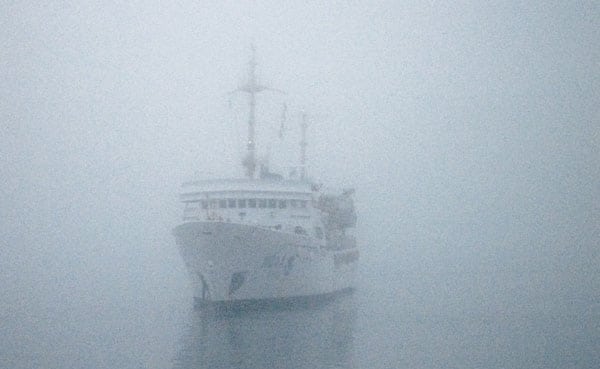
We all know the chaos that would ensue if every driver on the road traveled in any direction he or she wanted, never signaled, had no brake lights and defended that independence fiercely with no worries about ever getting a traffic ticket. But basically, that’s how most people go boating! Sure, there are rules of the road, but many boaters either don’t know them or pay no attention.
While attitudes are changing slowly with the advent of state-required boating certificates and mandatory education, there’s still nobody really enforcing the finer points of the rules – such as signaling your intentions to surrounding vessels. You do this by using your horn with a proscribed pattern of blasts.
Every rule I address here can be found in the U.S. Coast Guard’s rules of the road manual. You can buy a copy at amazon.com or your local chandlery, or you can simply visit navcen.uscg.gov, and download both international and inland rules for free.
**Required Equipment **Boats shorter than 39.4 feet aren’t required by law to carry a whistle or bell, but must have “some way to make an appropriate signal.” Ergo, every boat built in America has some sort of horn.
If you regularly operate in a region prone to fog, it might be worthwhile to invest in one of the latest loudhailers. Most of these relatively inexpensive systems have preprogrammed fog signals, so you can simply push a button for the type of boat and function you are engaged in, and the hailer automatically sounds the correct signal at the appropriate intervals.
**Overtaking **The powered vessel overtaking another vessel must stay out of the way of the vessel ahead. In order to avoid surprises (like collisions), the overtaking vessel must signal both the intent to pass and on which side. One short blast of a horn means you will pass to the right. Two short blasts means you’ll pass to the left (like the fast lane). As with all horn signals, the vessel being overtaken must respond with agreement (by sounding the same signal) or with disagreement (by sounding the danger signal of five short blasts). Note that you can never answer one blast with two or vice versa.
**Head to Head **Just as we drive cars on the right side of the road here in America, the standard in nautical terms is the same – pass portside to portside. In this case, neither vessel has the right of way. Just to be sure, each boater should sound one short blast on the horn. However, if for some reason you plan to pass starboard to starboard, you would issue two short blasts and hope the oncoming vessel agrees. By the way, those readers who travel down the Mississippi River or certain western rivers to get to open water should remember that a vessel traveling down-current always has the right of way for obvious maneuverability reasons.
**Backing Up **
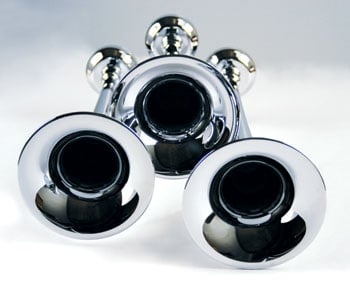
While signaling doesn’t seem as important for small boats leaving slips in a marina, it can be very important for larger vessels that can’t start and stop on a sand dollar like little outboard boats. Even so, it’s not a bad habit to adopt. Prior to backing, you should sound one long (two seconds will do) and three short (a second or less) blasts on your horn, then proceed. The signal doesn’t require agreement or response from surrounding vessels.
**Approaching a Bridge **Most drawbridges have marine VHF radio communications. Often, the expedient way to get a bridge to open is to call the tender on channel 13 or 9 (whichever is used locally). However, in the rare case where the bridge tender has no radio or has taken a nap, the appropriate horn signal consists of one long blast followed by a single short blast. Standard procedure dictates the bridge tender warn boats with five short blasts when the spans start to close. If you happen to be under the bridge when you hear those horns, respond immediately with five or more short blasts so the tender can hold open the spans until you’re clear.
**In a Fog **The rules of the road clearly state that if you are in fog and you hear another vessel’s signal, you must slow dramatically or stop until you determine there is no risk of collision. If you hear a horn in the fog, know that it’s a vessel underway. The specific combination of signals will tell you the kind of vessel. If you hear a bell or gong, that’s a vessel that is stopped for some reason – probably anchored or aground.
A powerboat underway in fog must sound one long blast every two minutes or less.
If that boater is stopped (but can maneuver), he must sound two long blasts about two seconds apart at intervals of two minutes or less.
A vessel engaged in fishing (lines, nets or trawling) must sound one long and two short blasts, again at intervals no longer than two minutes. Interestingly, this is the same signal required of a sailboat under sail. Go figure.
**When Anchored **Anchored boats shorter than 39.4 feet LOA must make some noise (preferably with a bell) every two minutes or less. Vessels larger than 39.4 but shorter than 328 feet must rapidly ring a loud bell for about five seconds at intervals of one minute or less.
Like auto insurance, this information is something you might never need. However, suddenly needing it even once will make your effort to know these rules very worthwhile.
- More: Boating Skills , Fishing and Boating Tips
- More How To
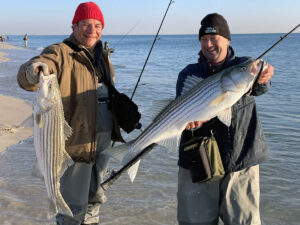
QUICK GUIDE: Surf Fishing Etiquette

Fishing With Crabs as Bait
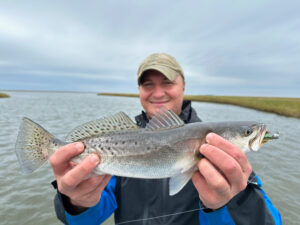
West Winds Are the Best Winds
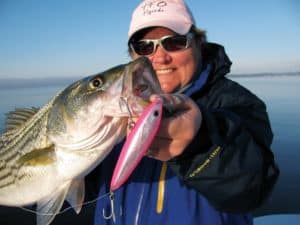
Best Striped Bass Lures
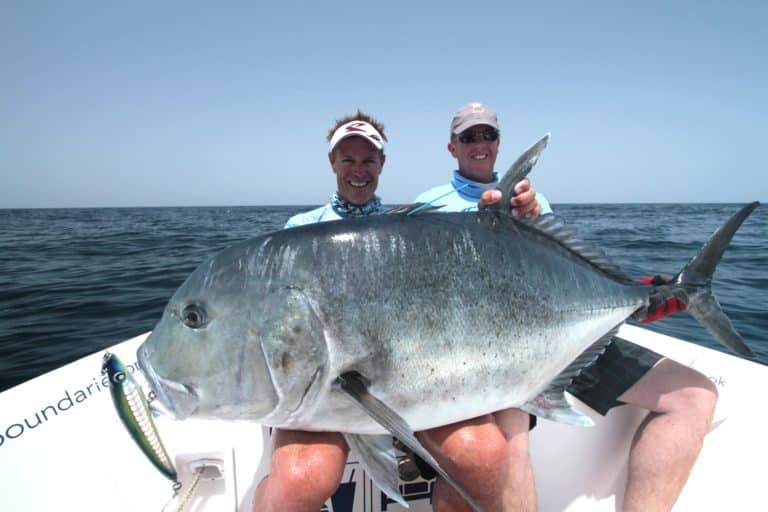
Toughest Nearshore Game Fish
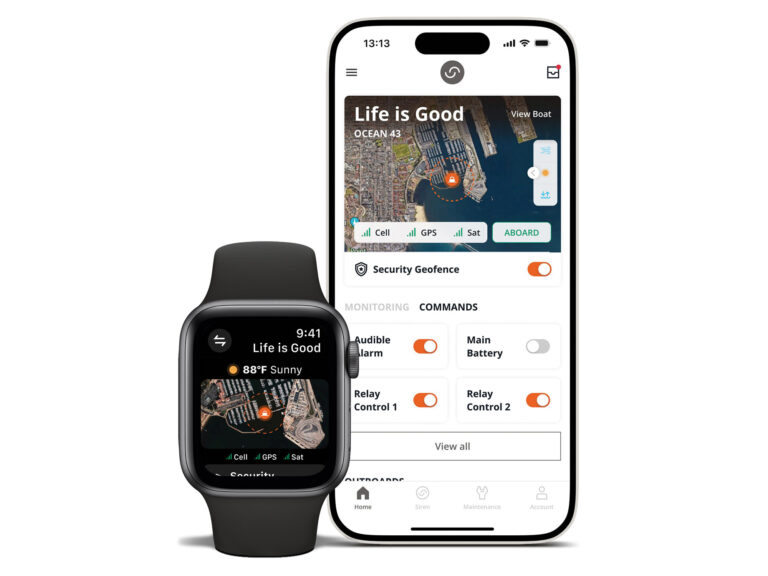
New Gear: The Siren Connected Boat App
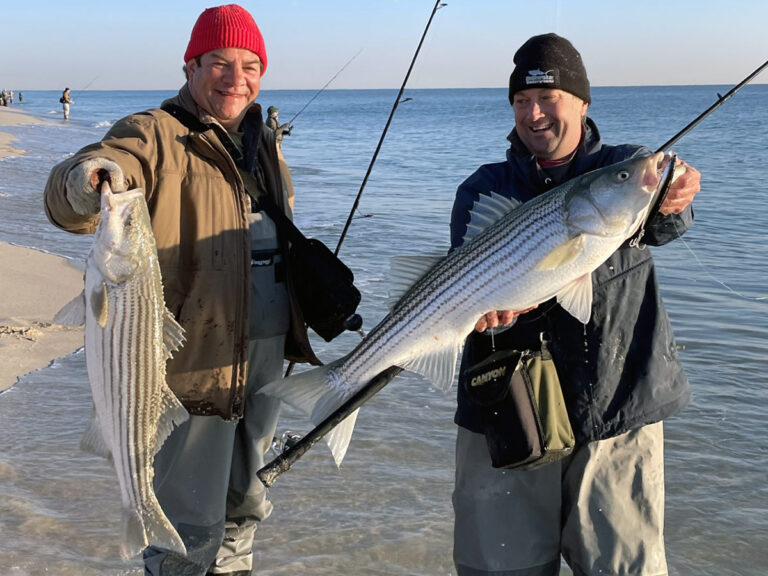
- Privacy Policy
- Cruising World
- Sailing World
- Salt Water Sportsman
- Sport Fishing
- Wakeboarding
Many products featured on this site were editorially chosen. Sport Fishing may receive financial compensation for products purchased through this site.
Copyright © 2024 Sport Fishing Firecrown . All rights reserved. Reproduction in whole or in part without permission is prohibited.
- AI Generator
Premium Access
Custom content, media manager.
Grow your brand authentically by sharing brand content with the internet’s creators.
1,770 Sailboat In Fog Stock Photos & High-Res Pictures
Browse 1,770 sailboat in fog photos and images available, or start a new search to explore more photos and images..
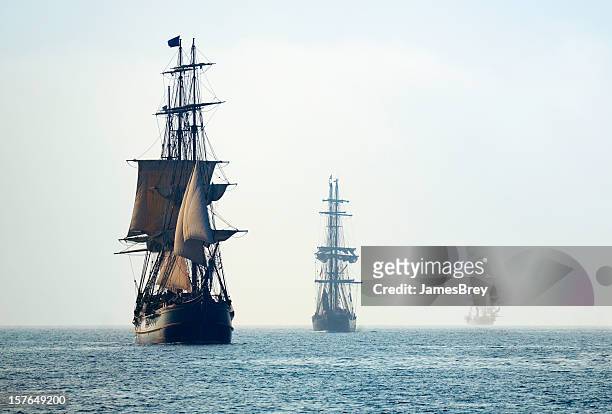
- Boat Handling
- DIY / Projects
- Environment
- Knots to Know
- Marine Electronics

Navigating in fog
Since navigating in fog can present serious challenges, boaters need to have a plan to deal with fog before it occurs.
“Storms announce their arrival with bravado—a fanfare of wind, rain or snow. Fog arrives stealthily, and oftentimes quickly, with silent restraint,” said Ronald Kessel, past Marine Environment Committee chair of United States Power Squadrons, America’s Boating Club. “There is no other weather event where your safety is so dependent on other boaters or where your responsibility to other boaters is greater.”
Fog restricts visibility, making it difficult or impossible to see and be seen by other boaters with the naked eye. When you can’t see the horizon, you can lose your bearings and experience temporary disorientation. Fog also dampens some sound frequencies, making it difficult to discern the direction from which sound is coming. These factors increase the risk of collision, grounding and injury.
What to do in restricted visibility
Kessel advises that any prudent boater should delay getting underway when fog is present or forecast. However, if you’re caught in fog, you can take three immediate actions to stay safe:
- Reduce speed to be able to stop within half the visible distance.
- Ensure everyone on board is wearing a life jacket, preferably a high-visibility vest equipped with reflective tape, a whistle and an EPIRB.
- Make sure your running lights are on: You want to be seen.
Your lookouts should be vigilant, looking and listening for nearby vessels and buoys. Reducing your own engine noise momentarily can help. You and your crew should be familiar with the sound signals—horns and bells—used to warn others around you of your proximity, relative bearing, and whether you are underway or anchored.
Periodically fix your position using your GPS or a chart, and use your compass to navigate in the right direction. Alternatively, stop until the fog lifts and do all you can to ensure you are in a safe location—out of shipping channels—where other boat traffic is unlikely.
Using your equipment to navigate
Marine electronics provide vital support:
- Your VHF marine radio helps you to monitor NOAA weather forecasts about changing fog conditions and communicate with other boaters.
- Radar helps you know about other vessels, objects and dangers around you; and radar reflectors make your vessel’s target image brighter and bigger on another boat’s radar monitor.
- AIS helps you and other AIS-enabled vessels transmit and receive data about vessel identity, location and closest points of approach. One of the advantages of AIS is that, unlike radar, AIS makes a full-size target image on the other boat’s monitor regardless of the size or type of boat transmitting the AIS data.
- Fish finders and sonar help you reconfirm your position against charted depths.
All contribute to vessel readiness, safe navigation and seamanship—provided you and your crew know how to use them.

Forecast the weather
Learn about the fundamentals of weather, basic meteorology and weather systems with this online course.
Related Posts

- Build A Boat
- Find A Dealer

- Staying Safe on the Water: How to Boat in Fog
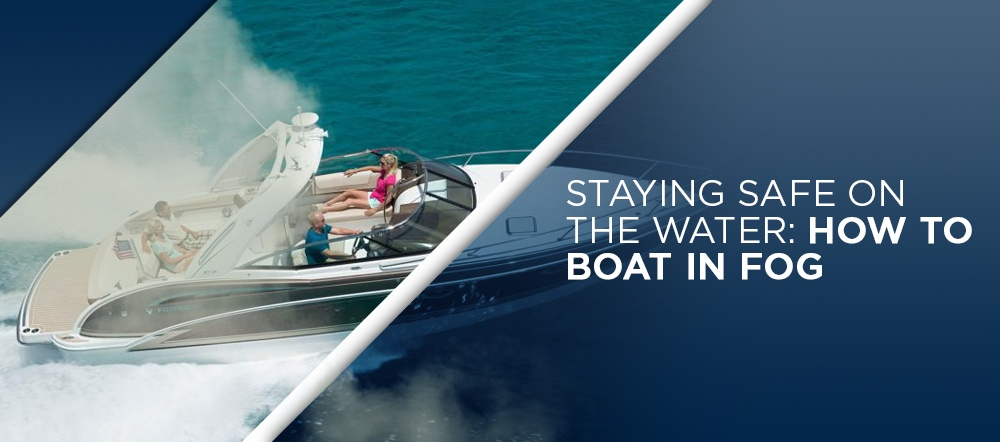
According to a 2018 report released by the U.S. Coast Guard, collision with other recreational vessels and stationary objects are the top two causes of boating-related accidents in the United States. Often, the reason for these collisions is reduced visibility. Several things can cause reduced visibility, including sudden, unexpected fog cover. Although common, boating into dense fog requires preparation, vigilance and a plan. This article covers the hazard of operating in restricted visibility, as well as some helpful tips for fog safety.
The Importance of Being Prepared for Fog While Boating
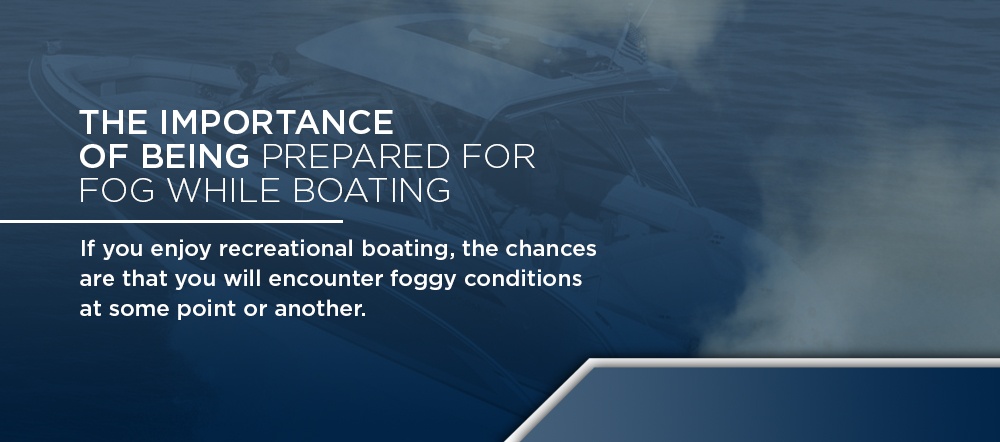
THE DANGERS OF FOG
Heavy fog makes it nearly impossible to see your surroundings, which increases the likelihood of a collision or getting lost.
- Collisions: One of the biggest dangers of fog is the threat of colliding with another vessel, which is why the U.S. Coast Guard has guidelines for sounding location signals during periods of low visibility. Other boats aren’t the only thing you can collide with, however. Be on your guard for natural and foreign obstacles, including buoys, rocks, sandbars and the shoreline.
- Getting lost: Even if you know the body of water well, fog is very disorienting. Getting lost can happen before you even realize you’ve veered off course. For this reason, it is crucial that you immediately slow down and fix your location. Never rely on GPS alone.
USEFUL ITEMS FOR BOATING IN HEAVY FOG
Any level of fog can be hazardous if you’re not prepared. Even if the weather shows no indication of fog cover, consider stocking your boat with the following items, just in case:
Map and compass: A boat with built-in GPS navigation is very useful, but you should avoid relying on technology alone. Keep a paper map and a compass on board so you can guide yourself back on course if you get lost during unexpected fog — especially if you’re boating in unfamiliar waters.
Flares and a flashlight: Both flares and a heavy-duty flashlight can help you signal your location to other oncoming vessels in dense fog.
Marine radar: A marine radar can help you avoid a collision, but remember, they may not detect every vessel, including small boats or kayaks. For additional protection, use a marine radar and a depth reader to watch for other route obstructions.
Radio: You can use your radio to listen to weather and fog alerts, communicate with your destination point or make noise while alerting other vessels of your location.
High-visibility life vests: Every boat should be stocked with enough lifejackets for every member on board. Look for vests that offer additional protection, such as lights or reflective strips, to promote visibility if someone falls into the water during heavy fog. Keep all life vests stored in a safe, easily accessible place when not in use.
Sound signaling device: Sound signaling devices are one of the most important tools to have on board, especially during periods of heavy fog and reduced visibility. The three main types of sound signaling devices are air horns, whistles, and ship bells. Air horns are ideal for portability and emitting loud, easily recognizable sounds. Always have more than one air horn on board, just in case the fog lasts longer than anticipated, and you need to continue signaling your location for other boaters. Whistles are great for wearing around your neck and can be very useful for finding someone in a man overboard situation. Finally, larger vessels often have a built-in ship bell that can be used to signal your location, as well as communicate with other vessels on the water.
HAVE AN EMERGENCY FOG PLAN IN PLACE
It’s a good idea to have an emergency plan in place before any boat trip. A plan can help you prepare for hazardous situations and offer all passengers peace of mind. Here are some things to consider when establishing your own emergency fog plan:
- Assign each passenger a role to fill in the event of unexpected fog cover. For example, you can assign someone to watch the back end of the boat, someone to prepare the air horn and someone to monitor the radar.
- Review where passengers can find their life vests and how to wear them, as well as procedures regarding the safest way to handle a man overboard situation.
- Make sure all of your passengers understand the importance of remaining calm and quiet during unexpected fog. Empowering friends and family with this knowledge will help ease any tension or uncertainty during a time when staying focused is crucial.
- Avoid boating while under the influence of alcohol, so if an emergency arises, you are equipped to handle it.
By putting these tips for boating in fog into practice, you and your passengers are less likely to feel unprepared or uneasy about reduced visibility.
How to Know If It Might Get Foggy
Always check the weather forecast for fog advisories before you head out for a day on the water. Fog is likely when one or more of the following conditions are present:
- When a rainshower is followed by a period of low-wind and clear skies.
- When overnight skies are clear, allowing surface temperatures to cool more quickly.
- When wind movement occurs from the direction of the water, gathering moisture.
- When warm, moist air blows over a body of cold water.
There are several different types of fog , but the two most likely to affect your time on the boat are advection fog and radiation fog. Advection fog — also known as sea fog or lake fog — is fog caused by moist air moving over a cool surface and is common over bodies of water. Radiation fog is the dense fog that often rolls in overnight and usually begins on land before moving over bodies of calm water.
What to Do If You Get Caught in Fog
Sometimes, fog can roll in without any indication in the weather forecast. When this happens, the most important thing to do is to stay calm and vigilant, while following these steps:
- Take your bearings and mark your location on a chart or electronic plotter.
- Slow your speed down as slow as you can without coming to a complete stop. Continue to log your course and speed.
- Turn on your navigation lights and prepare your emergency gear, such as reflective life vests and air horns.
- If you are boating with others, assign people to act as lookouts on all sides of your vessel.
HOW DO YOU NAVIGATE A BOAT IN FOG?
Navigating a boat in reduced visibility requires a significant level of care and attention. “Reduced visibility” or “restricted visibility” refers to any condition in which you have difficulty seeing due to fog, mist, inclement weather or other similar causes. Typically, fog is considered “dense fog” if you can see one or fewer nautical miles away.
The internationally recognized standards for reduced visibility on the water are:
- Very Poor: If you can see less than a one-half nautical mile away, visibility is considered very poor.
- Poor: If you can see between one-half and 2 nautical miles away, visibility is considered poor.
- Moderate: If you can see between 2 and 5 nautical miles away, visibility is considered moderate.
- Good: If you can see 5 or more nautical miles away, visibility is considered good.
The U.S. Coast Guard requires that all vessels 65.5 feet or less follow certain lighting requirements for both power and sail-driven boats in these situations. Follow these tips for operating in restricted visibility:
- Listen carefully: Listen carefully to your surroundings for any audible signs of oncoming vessels, including boat engines, air horns and whistles.
- Make noise: Make enough noise so other vessels can hear you through the fog. During periods of heavy fog, you are required to make five-second blasts with an air horn or whistle every minute. Making noise can also help you better assess your location if you listen to the signal’s echo. In the next section, we’ll dive deeper into the signals and warning sounds for boating in fog.
- Stop when necessary: As a general rule, you should avoid anchoring your boat in dense fog to prevent becoming a stationary obstacle for other vessels. However, should conditions become unsafe to travel, it’s better to anchor and wait it out. Should you need to stop, never do so at the mouth of an inlet. Follow all signal guidelines for sounding your anchored location.
- Keep your eyes moving: Because it can be very disorienting, avoid staring directly into the fog for too long. Instead, keep your eyes moving. Scan around the entire boat, and regularly check on your passengers.
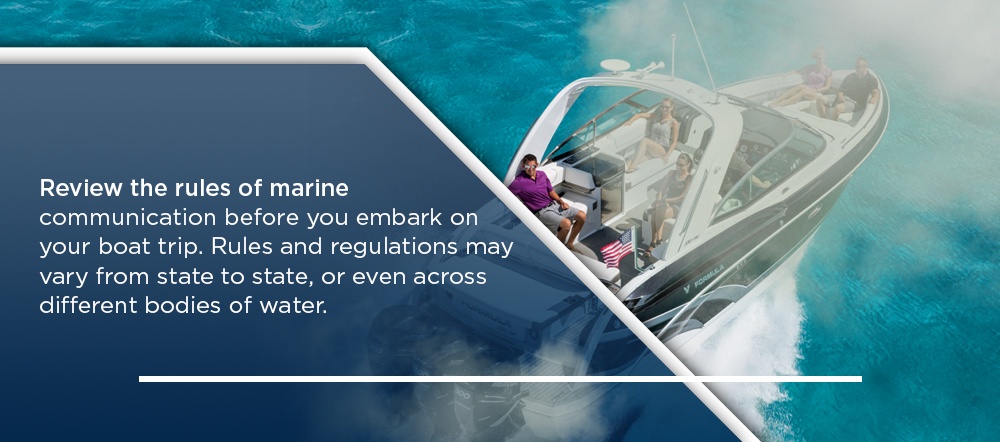
SOUNDS AND SIGNALS FOR NAVIGATING IN THE FOG
We’ve reviewed how important it is to make your vessel’s location known, and to listen carefully for signs of nearby obstacles — but what signals should you be listening for? There are two different types of sound blasts to be aware of: short blasts and prolonged blasts. Short sound blasts last about one second, while prolonged blasts last between four and six seconds.
Review the rules of marine communication before you embark on your boat trip. Rules and regulations may vary from state to state, or even across different bodies of water. Additionally, when boating on unfamiliar waters, it’s always a good idea to ask those familiar if there are any natural formations you should be aware of, such as islands or sandbars. Many boaters find it helpful to keep a copy of the various signals and their meanings on board, so they are easily accessible if needed.
Some common sounds to listen for include:
- One short blast: A single, short blast likely indicates that the vessel intends to pass you on their port — or left — side.
- Two short blasts: Two short blasts made in succession mean the vessel intends to pass you on their starboard — or right — side.
- Three short blasts: Three short blasts indicate the vessel is using “astern propulsion,” which could mean they are backing up and need the area to remain clear.
When operating in restricted visibility, such as in the fog, pay close attention to the location of the blasts, as well as their duration. Use these guidelines for communicating with fellow boaters in the fog:
- One prolonged blast: If you hear a single, prolonged blast that lasts no more than two minutes, this indicates there is a power-operated vessel underway nearby. They could be alerting you of their presence or signaling a nearby hazard. Proceed cautiously.
- One prolonged blast plus two short blasts: A single, prolonged blast followed by two short blasts lasting no more than two minutes means a sailboat is underway nearby.
- Two prolonged blasts: Power-operated boats use two prolonged blasts every two minutes to indicate they are underway nearby, but not moving.
- Five or more short, rapid blasts: Five or more short, rapid blasts mean danger is near, or that a vessel has taken issue with you or another vessel’s intentions.
When sounding your own blasts, never sound a single blast for too long. This way, every vessel has a chance to be heard, and collisions are more easily avoided. If you have to anchor or have run aground, it’s crucial that you continue to make your location known using the following signals:
- Anchored: If you are anchored, make sounds in five-second increments, every 60 seconds, until you are once again underway.
- Run aground: If your vessel has run aground, sound three blasts or bell strokes, followed by five seconds of rapid bell ringing or horn blasting, followed by an additional three strokes or blasts every minute.
About Formula Boats and Our Navigation Systems
Formula Boats specializes in producing beautiful, comfortable vessels that go above and beyond your performance expectations. We understand that a boat is an investment — so you should be able to choose a boat that fits your unique wants and needs . That’s where the FormulaFlex Program comes in.
Our FormulaFlex Program allows you to custom choose different aspects of your boat’s design, including:
- The hull and outboard: With FormulaFlex MyWay™, choose between a virtually limitless number of high-quality graphic and color combinations for the hull and outboard of your vessel.
- Upholstery and cabin interior: Choose the color of your accent piping and have full control over the pattern of your upholstery, drapery and cushions. Whether your tastes are modern and chic or classic and coastal, we’ve got something for you.
- Electronics and helm layout: Customize your dash panel gauges and electronics layout to suit your preferences, including special upgrades. Our experts will work with you to create the optimal setup.
- Optional features: As you build your ideal Formula boat, you have the option to add features designed to enhance your boating experience, like a built-in Raymarine Axiom™ GPS. Specific Raymarine Axiom navigation systems vary, depending on which boat model you are customizing.
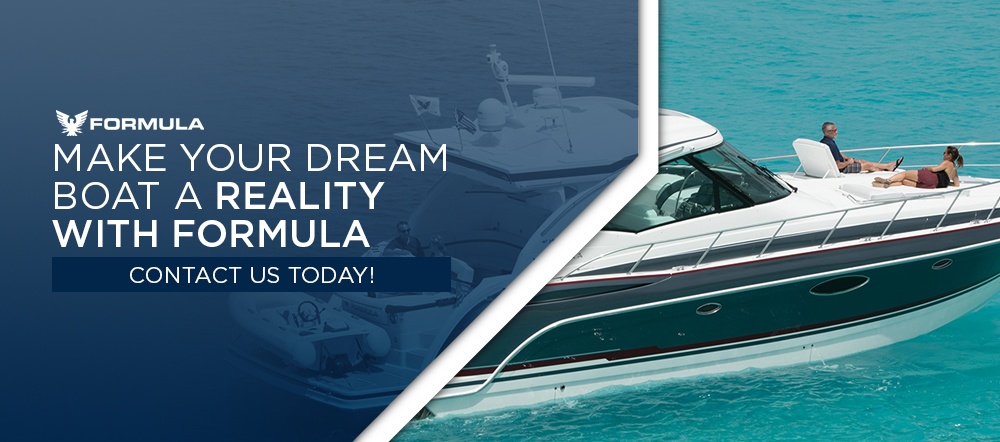
Make Your Dream Boat a Reality With Formula
Explore our website to learn more about our vessels or custom building process. You can also request a free catalog , which includes information about Formula dealers near you .
Contact Dealer
This site is protected by reCAPTCHA and the Google Privacy Policy and Terms of Service apply
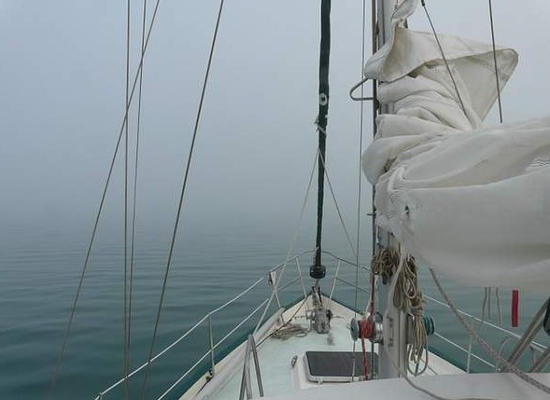
A Sailboat Is Underway In The Fog. What Sound signal Should You Hear?

In the fog when visibility to see around your boat is 0 or under 1 km. Sound Signals used to let other boats know where you actually located during the fog and Restricted visibility.
when you hear the signal of a vessel you cannot see, slow your boat to a minimum speed, until you are not that you are out of the risk.
Here is the some simple steps that you should follow for signals:
- 1 Extended Blast and more then 3 short Blasts every 2 minutes.
- You can use Red Star Shells To let other boater know.
- Use Fog Horn continuous soundings
- Flames on a vessel
- Gun fired at Intervals of One Minute.
If you have any other more information about please leave us a comment below and let us know about this.
Related Posts
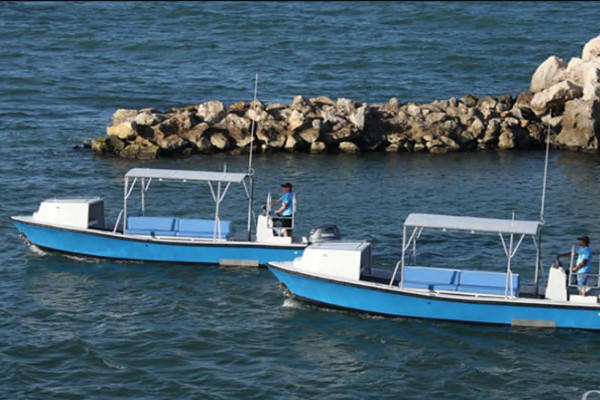
Two Boats Are Operating Near Each Other. Which is the boat that must maintain its course and speed?

While boating, you see a red flag with a white diagonal stripe. What does this flag mean?
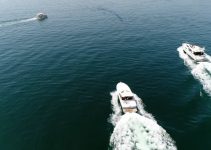
How Should You Pass a Fishing Boat – Follow The Nautical Rules
Leave a reply cancel reply.
This site uses Akismet to reduce spam. Learn how your comment data is processed .
Privacy Overview

- Rivers and Lakes
- Severe Weather
- Fire Weather
- Long Range Forecasts
- Climate Prediction
- Space Weather
- Past Weather
- Heating/Cooling Days
- Monthly Temperatures
- Astronomical Data
- Beach Hazards
- Air Quality
- Safe Boating
- Rip Currents
- Thunderstorms
- Sun (Ultraviolet Radiation)
- Safety Campaigns
- Winter Weather
- Wireless Emergency Alerts
- Weather-Ready Nation
- Cooperative Observers
- Daily Briefing
- Damage/Fatality/Injury Statistics
- Forecast Models
- GIS Data Portal
- NOAA Weather Radio
- Publications
- SKYWARN Storm Spotters
- TsunamiReady
- Service Change Notices
- Be A Force of Nature
- NWS Education Home
- Pubs/Brochures/Booklets
- NWS Media Contacts
NWS All NOAA
- Organization
- Strategic Plan
- Commitment to Diversity
- For NWS Employees
- International
- National Centers
- Social Media
National Program
Boating in Fog
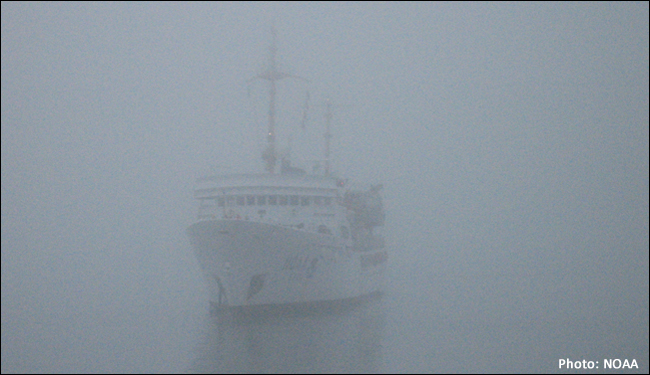
Chances are when you are on the water you will occasionally encounter fog, making navigation a challenge. Because of the time it can take to stop or turn a marine vessel, fog is usually considered dense for mariners if it reduces visibility to less than 1 mile. Fog can form quickly and catch boaters off guard. Visibility can be reduced to a few feet, which can disorient even the most experienced boaters. The international standards for describing reduced visibility in marine forecasts are as follows:
- Very Poor: Less than 0.5 nautical miles
- Poor: 0.5 to less than 2 nautical miles
- Moderate: 2 to 5 nautical miles
- Good: Greater than 5 nautical miles
Learning to navigate through fog (or avoiding it) is critical to safe boating . These safety tips will help to keep you safe:
- Slow down to avoid collisions.
- Turn on all of your running lights, even in daytime.
- Listen for sounds of other boats that may be near you or for fog horns and bells from nearby buoys.
- VHF NOAA Weather Radio should broadcast important information concerning the formation, movement or dissipation of the fog. Pay close attention.
- If your vessel has radar, use it to help locate dangers that may be around you.
- Use GPS or a navigation chart to help obtain a fix on your location.
- If you are unable to get your bearings, stay put until the fog lifts but make sure you are in a safe location.
- Be familiar with horn and bell sounds you should produce to warn others around you when in dense fog.
- Have a compass available. Even if you don't know where you are in the fog, with a compass you can determine the direction you are navigating.
- Stay out of shipping lanes. Large ships cannot see you! Learn more about safe boating in fog
US Dept of Commerce National Oceanic and Atmospheric Administration National Weather Service Safety 1325 East West Highway Silver Spring, MD 20910 Comments? Questions? Please Contact Us.

- Flashlights
- Path Lights
- Bike Lights

- Safety Lights
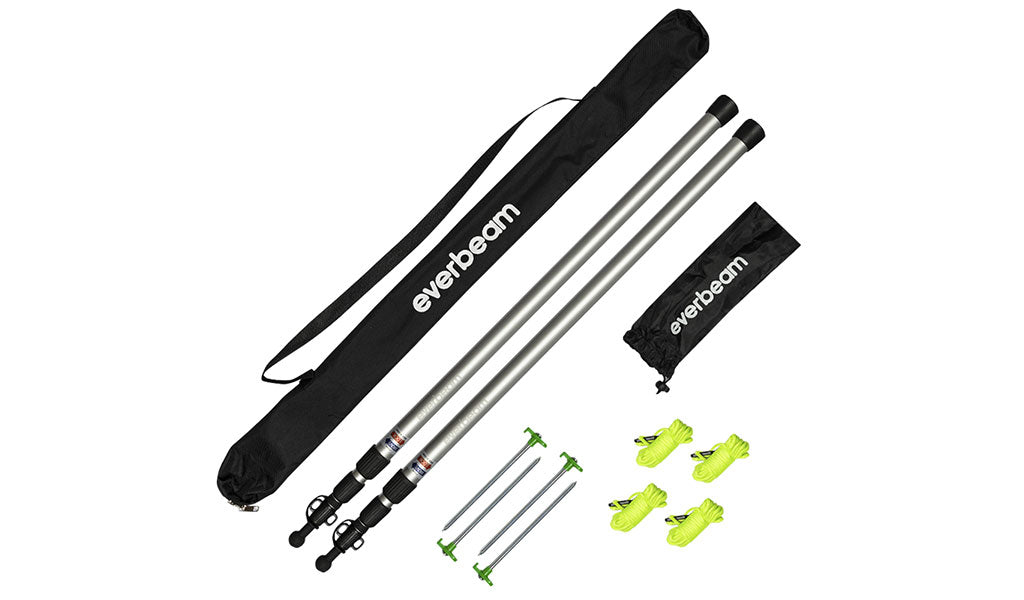
- Accessories
- Bike Cleats
May 20, 2022 14 min read
A Powerboat Underway in the Fog: What Sound Signal Should You Use?

When you're operating a powerboat in the fog, sound signals are critical for safety. They help you navigate through the reduced visibility and alert other vessels to your presence. But which sound signals should you use? The answer depends on the type of vessel you're operating and your intentions.
Understanding the impact of fog on boating is crucial to operating safely. Fog can reduce visibility to as little as a few feet, making it difficult to see other boats, buoys, and landmarks. This can lead to collisions, groundings, and other accidents. Using sound signals can help prevent these accidents and keep you and other boaters safe. In this article, we'll explore the different sound signals you should use when operating a powerboat in the fog, as well as other safety measures you can take to stay safe in these conditions.
Key Takeaways
- Understanding the impact of fog on boating is crucial to operating safely.
- Sound signals are critical for safety when operating a powerboat in the fog.
- The type of vessel you're operating and your intentions determine which sound signals you should use.
Understanding Fog and Its Impact on Boating
When boating in fog , it's essential to understand how it can impact your visibility and ability to navigate safely. Fog is a type of mist that can reduce visibility to less than one nautical mile, making it difficult to see other vessels, obstacles, or land masses. This can be especially dangerous when boating in areas with heavy traffic or narrow channels.
Restricted visibility due to fog can also impact your ability to navigate using visual aids such as buoys, markers, or lighthouses. It's important to have a solid understanding of your vessel's navigation equipment and how to use it properly to navigate in these conditions.
Before heading out, it's crucial to check the weather forecast for any potential fog or reduced visibility in your area. If fog is expected, it's best to delay your trip until conditions improve. If you do encounter fog while underway, it's essential to slow down and use your vessel's sound signals to alert other boats of your presence.
In summary, fog can be a significant hazard to boaters, and it's crucial to understand how it can impact your visibility and navigation. By being prepared and using proper navigation techniques, you can safely navigate through foggy conditions and avoid any potential accidents.
The Importance of Sound Signals in Fog
When operating a powerboat in foggy conditions, it's crucial to use sound signals to alert other boats of your presence. The sound signals are used to indicate the boat's position, direction, and proximity to other boats. The most common sound signal is a short blast, which is used to indicate that the boat is altering its course to starboard.
A prolonged blast, on the other hand, is used to indicate that the boat is altering its course to port. It's also important to note that blasts are used to indicate the boat's position when it's underway. For example, one short blast indicates that the boat is approaching another boat head-on, while one prolonged blast indicates that the boat is overtaking another boat from behind.
Three short blasts are used to indicate that the boat is backing up, while rapid blasts are used to indicate danger or an emergency situation. It's essential to use the correct sound signal in the appropriate situation to avoid confusion or accidents.
In addition to using sound signals, it's also important to have a fog signal on board. A fog signal is a sound-producing device that emits a loud, distinctive sound to alert other boats of your presence. Fog signals can be in the form of horns, whistles, or bells.
In summary, when operating a powerboat in foggy conditions, it's crucial to use sound signals and fog signals to alert other boats of your presence. Using the correct sound signal in the appropriate situation can prevent confusion and accidents.
Types of Vessels and Their Sound Signals
When underway in foggy conditions, it's crucial to understand the different types of vessels and their corresponding sound signals. Powerboats, sailing vessels, and power-driven vessels all have different sound signals that they should use to alert other boats of their presence.
For powerboats, a prolonged blast of the horn is the appropriate sound signal. This is a sound that lasts for four to six seconds and should be used every two minutes when underway in foggy conditions.
Sailing vessels, on the other hand, should use a combination of sound signals. If the sailing vessel is under sail alone, it should sound a prolonged blast every two minutes. If the sailing vessel is also using its engines, it should sound a prolonged blast followed by two short blasts every two minutes.
Power-driven vessels should sound a prolonged blast followed by two short blasts every two minutes when underway in foggy conditions. This includes vessels like motorboats and speedboats.
It's also important to know the sound signals for vessels being overtaken and vessels engaged in fishing. When overtaking another vessel, sound two short blasts followed by a prolonged blast every two minutes. When in the vicinity of a vessel engaged in fishing, sound two prolonged blasts followed by one short blast every two minutes.
By understanding the different sound signals for each type of vessel , you can help ensure safe navigation in foggy conditions.
Understanding Port and Starboard
When you're on a powerboat that's underway in the fog, it's essential to understand port and starboard. Port refers to the left side of the boat, while starboard refers to the right side. These terms are used to communicate with other vessels and to navigate safely through the water.
It's important to note that port and starboard are always relative to the direction the boat is facing. So, if you're standing at the back of the boat facing forward, port will be on your left, and starboard will be on your right.
Knowing the difference between port and starboard is crucial for understanding navigation rules, which dictate who has the right of way when two boats are approaching each other. For example, if two boats are approaching each other head-on, both should turn to starboard (right) to avoid a collision.
When you're on a boat, you'll often hear the terms "port side" and "starboard side" used to refer to specific areas of the boat. Port side refers to the left side of the boat, while starboard side refers to the right side.
In summary, understanding port and starboard is essential for safe navigation on the water. Whether you're communicating with other vessels or following navigation rules, knowing the difference between port and starboard will help keep you and your passengers safe.
Maneuvering and Warning Signals
When operating a powerboat in the fog, it is crucial to use maneuvering and warning signals to avoid collisions and ensure the safety of all on board. The sound signal to use in restricted visibility is one prolonged blast at intervals of not more than two minutes. This signal is used to warn other vessels of your presence and to indicate that you are underway.
If you are approaching another vessel in the fog, you should use a danger signal of five short blasts. This signal indicates that you are in a potentially dangerous situation and that the other vessel should take action to avoid a collision. If you are proposing a maneuver, such as turning to port or starboard, you should use the appropriate maneuvering signal of two short blasts for port and three short blasts for starboard.
It is important to remember that sound signals alone are not enough to prevent collisions in restricted visibility. You should also reduce your speed and keep a sharp lookout for other vessels and navigational hazards. By using the correct maneuvering and warning signals and taking appropriate precautions, you can safely navigate your powerboat through the fog.
Legal Requirements and Coast Guard Regulations
When operating a powerboat in the fog, it is important to follow legal requirements and Coast Guard regulations to ensure safety. According to the Navigation Rules, a power-driven vessel underway in fog must sound a prolonged blast at intervals of not more than two minutes. This signal indicates the presence of a power-driven vessel and its position to other vessels in the area.
The U.S. Coast Guard also has regulations that must be followed when operating a powerboat in the fog. These regulations include having proper navigation lights, maintaining a safe speed, and using radar if available. It is important to follow these regulations to prevent collisions and ensure the safety of everyone on board.
International rules and inland rules also apply when operating a powerboat in the fog. It is important to be familiar with these rules to ensure compliance and safety. In addition, it is recommended to have a sound signaling device, such as a whistle or horn, on board in case of emergency.
In summary, when operating a powerboat in the fog, it is important to follow legal requirements and Coast Guard regulations. This includes sounding a prolonged blast at intervals of not more than two minutes, having proper navigation lights, maintaining a safe speed, and using radar if available. By following these regulations, you can ensure the safety of everyone on board and prevent collisions with other vessels.
Additional Safety Measures
When underway in the fog, it is essential to take additional safety measures to ensure a safe and successful journey. One such measure is to maintain a proper lookout at all times. This includes having someone designated to watch for any obstructions or blind bends, as well as keeping an eye out for other boats in the area.
In addition to a lookout, it is recommended to use radar to detect any potential risks of collision. This technology can help you identify any obstructions in the water, even if they are not visible to the naked eye. It is important to note that radar should not be solely relied upon and should be used in conjunction with other safety measures.
When leaving the dock, it is important to have a plan in place for navigating through the fog. This may include plotting a course, identifying potential hazards, and communicating with other boats in the area. It is also recommended to reduce your speed and maintain a safe distance from other boats to reduce the risk of collision.
Overall, taking these additional safety measures can greatly reduce the risk of accidents and ensure a safe and successful journey when underway in the fog.
Communication Tools in Foggy Conditions
When operating a powerboat in foggy conditions, it is crucial to have the right communication tools to ensure the safety of everyone on board. One of the most important tools is a sound signal. The sound signal should be used to alert other boats of your presence and to indicate your intentions.
There are several types of sound signals that are commonly used in foggy conditions. These include a bell, whistle, air horn, and radio. The sound signal that you use will depend on the size of your boat and the conditions that you are operating in.
A bell is typically used on smaller boats and is required by law on vessels under 12 meters in length. The bell should be rung for five seconds every minute in foggy conditions.
A whistle is another common sound signal that is used in foggy conditions. The whistle should be sounded for four to six seconds every minute in foggy conditions.
An air horn is a more powerful sound signal that is used on larger boats. The air horn should be sounded for four to six seconds every minute in foggy conditions.
In addition to these sound signals, it is also important to have a radio on board. The radio can be used to communicate with other boats and to receive weather updates and other important information.
When using a sound signal, it is important to ensure that it is loud enough to be heard by other boats in the area. You should also be aware of the mouth of the bell, which is the direction that the sound travels in. This will help you to determine the best direction to sound your signal in.
Overall, having the right communication tools is essential when operating a powerboat in foggy conditions. By using the appropriate sound signals and staying alert, you can help to ensure the safety of yourself and others on board.
Understanding and Responding to Disagreement Signals
When operating a powerboat in the fog, it's crucial to understand and respond to disagreement signals. Disagreement signals are used to indicate that two vessels are on a collision course and that one vessel must take action to avoid a collision. The International Regulations for Preventing Collisions at Sea (COLREGs) specify the sound signals that should be used in this situation.
If you hear one short blast, it means that the other vessel is in agreement with your proposed course of action. If you hear two short blasts, it means that the other vessel disagrees with your proposed course of action and that you should take action to avoid a collision. In this situation, you should alter your course to starboard (right) to avoid the other vessel.
If you hear three short blasts, it means that the other vessel is in doubt about your proposed course of action and that you should take action to avoid a collision. In this situation, you should alter your course to starboard (right) to avoid the other vessel.
It's important to respond to disagreement signals promptly and appropriately to avoid a collision. If you're unsure about how to respond, slow down and wait for further instructions. Remember, safety should always be your top priority when operating a powerboat in the fog.
Special Circumstances
When operating a powerboat in the fog, it is important to be aware of special circumstances that may require sound signals. Sound signals are used to alert other vessels of your presence and intentions.
If you are underway in the fog, you should sound one prolonged blast at intervals of not more than two minutes. If you are anchored, you should sound one short blast followed by one prolonged blast at intervals of not more than one minute.
If you are aground, you should sound three distinct strokes in quick succession, followed by one prolonged blast at intervals of not more than two minutes. If you are backing up, you should sound one short blast every two minutes.
If you have astern propulsion, you should sound one prolonged blast followed by three short blasts at intervals of not more than two minutes. If you are overtaking another vessel, you should sound two short blasts followed by one prolonged blast at intervals of not more than two minutes.
If you are towing another vessel, you should sound one prolonged blast followed by two short blasts at intervals of not more than two minutes.
Remember, sound signals are an important tool for communicating with other vessels in the fog. By following these guidelines, you can help ensure the safety of everyone on the water.
Boater Responsibilities and Intentions
As a boater, it is your responsibility to ensure the safety of yourself and others around you while underway in the fog. One of the most important ways to do this is by using the appropriate sound signals to indicate your intentions and alert other boaters to your presence.
If you are operating a powerboat in the fog, the sound signal you should use depends on your vessel's size and speed. For example, if you are underway and making way, you should sound one prolonged blast at intervals of no more than two minutes. If you are stopped and not making way, you should sound two prolonged blasts at intervals of no more than two minutes.
It is also important to remember that sound signals are not the only way to communicate with other boaters. You should always be aware of your surroundings and keep a lookout for other vessels, using visual signals such as navigation lights and flares if necessary.
By following these boater responsibilities and intentions, you can help ensure a safe and enjoyable boating experience for everyone on the water.
Sailing Vessels Vs. Power-Driven Vessels
When a powerboat is underway in the fog, it is important to know the sound signals that should be used to avoid collisions with other vessels. The rules for sound signals differ between sailing vessels and power-driven vessels.
Sailing vessels under sail alone should sound one prolonged blast at intervals not exceeding two minutes. Power-driven vessels should sound one prolonged blast followed by two short blasts at intervals not exceeding two minutes.
If a sailing vessel is being propelled by machinery, it should sound the same signals as a power-driven vessel. However, if a sailing vessel is being propelled by both sail and machinery, it should sound the same signals as a sailing vessel under sail alone.
It is important to note that if you hear a fog signal from another vessel, you should respond with the same signal. This will help other vessels to locate you and avoid a collision.
Rapid Bell Ringing and Its Significance
When a powerboat is underway in the fog, it is essential to use sound signals to alert other vessels of your presence. One of the most crucial sound signals is the bell, which is used to indicate the presence of a power-driven vessel.
Rapid bell ringing is an important sound signal that indicates that a vessel is in distress or is in danger of colliding with another vessel. This sound signal consists of five or more rapid rings of the bell in quick succession, followed by a short pause, and then repeated.
Rapid bell ringing is significant because it is used to indicate that a vessel is in distress and requires immediate assistance. It is also used to indicate that a vessel is in danger of colliding with another vessel and needs to take evasive action.
In addition to rapid bell ringing, there are other sound signals that powerboats can use to indicate their presence in the fog. These include the whistle, which is used to indicate the vessel's position, and the horn, which is used to indicate the vessel's intention to maneuver.
It is essential for all powerboat operators to understand the significance of sound signals and to use them appropriately when underway in the fog. By doing so, they can help prevent collisions and ensure the safety of everyone on board.
Seas and Fog
When navigating in foggy conditions, it is important to be aware of the sea state. Waves can become unpredictable and dangerous, even in calm conditions. Keep a lookout for any changes in the sea state, and adjust your speed and course accordingly.
In foggy conditions, you should sound a prolonged blast on your horn at intervals of no more than two minutes. This signal indicates that you are underway and cannot see other vessels. Other vessels in the area will also be sounding their horns, so listen carefully and keep track of their location.
If you are in an area with heavy traffic, you may also hear short blasts from other vessels. This signal indicates that they are altering their course to starboard (right). If you hear two short blasts, it means they are altering their course to port (left).
Remember to always proceed at a safe speed in foggy conditions. Slow down if necessary, and keep a lookout for other vessels. By following these guidelines, you can safely navigate through foggy conditions and avoid collisions with other boats.
Frequently Asked Questions
What is the meaning of one prolonged blast from a powerboat in foggy conditions.
One prolonged blast from a powerboat in foggy conditions indicates that the boat is underway and is not moving in relation to the fog. This is a warning signal that the boat is approaching other boats or objects and is requesting that they take appropriate action to avoid a collision.
What should you do when you hear a fog signal from a powerboat?
When you hear a fog signal from a powerboat, you should reduce your speed and proceed with caution. You should also listen carefully for other signals from the boat, such as the number of short blasts, to determine its position and direction.
How many sound signals are used when signaling to boaters about inclement weather?
When signaling to boaters about inclement weather, two sound signals are used. One prolonged blast is used to signal that the boat is underway, and three short blasts are used to signal that the boat is at anchor or stopped.
When should you have appointed lookouts in place while operating a boat?
You should have appointed lookouts in place while operating a boat in all conditions, including clear weather and foggy conditions. Lookouts should be positioned in a way that allows them to see in all directions and should be trained to identify and report any potential hazards.
What is the meaning of three short blasts from a boat?
Three short blasts from a boat indicate that the boat is at anchor or stopped and is not moving in relation to the fog. This signal is used to indicate the boat's position and direction.
What are the different sound signals used by boats and ships in foggy conditions?
The different sound signals used by boats and ships in foggy conditions include one prolonged blast to indicate that the boat is underway, two prolonged blasts to indicate that the boat is backing up, and three short blasts to indicate that the boat is at anchor or stopped. Additionally, boats and ships may use other signals, such as five short blasts to indicate danger or an emergency situation.
Advertisement
The Dali was just starting a 27-day voyage.
The ship had spent two days in Baltimore’s port before setting off.
- Share full article

By Claire Moses and Jenny Gross
- Published March 26, 2024 Updated March 27, 2024
The Dali was less than 30 minutes into its planned 27-day journey when the ship ran into the Francis Scott Key Bridge on Tuesday.
The ship, which was sailing under the Singaporean flag, was on its way to Sri Lanka and was supposed to arrive there on April 22, according to VesselFinder, a ship tracking website.
The Dali, which is nearly 1,000 feet long, left the Baltimore port around 1 a.m. Eastern on Tuesday. The ship had two pilots onboard, according to a statement by its owners, Grace Ocean Investment. There were 22 crew members on board, the Maritime & Port Authority of Singapore said in a statement. There were no reports of any injuries, Grace Ocean said.
Before heading off on its voyage, the Dali had returned to the United States from Panama on March 19, harboring in New York. It then arrived on Saturday in Baltimore, where it spent two days in the port.
Maersk, the shipping giant, said in a statement on Tuesday that it had chartered the vessel, which was carrying Maersk cargo. No Maersk crew and personnel were onboard, the statement said, adding that the company was monitoring the investigations being carried out by the authorities and by Synergy Group, the company that was operating the vessel.
“We are horrified by what has happened in Baltimore, and our thoughts are with all of those affected,” the Maersk statement said.
The Dali was built in 2015 by the South Korea-based Hyundai Heavy Industries. The following year, the ship was involved in a minor incident when it hit a stone wall at the port of Antwerp . The Dali sustained damage at the time, but no one was injured.
Claire Moses is a reporter for the Express desk in London. More about Claire Moses
Jenny Gross is a reporter for The Times in London covering breaking news and other topics. More about Jenny Gross
Six presumed dead after cargo ship crash levels Baltimore bridge
BALTIMORE — A major Baltimore bridge collapsed like a house of cards early Tuesday after it was struck by a container ship, sending six people to their deaths in the dark waters below, and closing one of the country’s busiest ports.
By nightfall, the desperate search for six people who were working on the bridge and vanished when it fell apart had become a grim search for bodies.
“We do not believe that we’re going to find any of these individuals still alive,” Coast Guard Rear Admiral Shannon N. Gilreath said.
Jeffrey Pritzker, executive vice president of Brawner Builders, said earlier that one of his workers had survived. He did not release their names.
Up until then, Maryland Gov. Wes Moore had held out hope that the missing people might be found even as law enforcement warned that the frigid water and the fact that there had been no sign of them since 1:30 a.m. when the ship struck Francis Scott Key Bridge.
Moore expressed heartbreak after officials suspended the search for survivors.
"Our heart goes out to the families," he said. "I can’t imagine how painful today has been for these families, how painful these hours have been have been for these families."
It was a crushing blow to the loved ones of the missing men, who had waited for hours at a Royal Farms convenience store near the entrance of the bridge for word of their fate.
Follow live updates on the Baltimore bridge collapse
The tragic chain of events began early Tuesday when the cargo ship Dali notified authorities that it had lost power and issued a mayday moments before the 984-foot vessel slammed into a bridge support at a speed of 8 knots, which is about 9 mph.
Moore declared a state of emergency while rescue crews using sonar detected at least five vehicles in the frigid 50-foot-deep water: three passenger cars, a cement truck and another vehicle of some kind. Authorities do not believe anyone was inside the vehicles.
Investigators quickly concluded that it was an accident and not an act of terrorism.
Ship was involved in another collision
Earlier, two people were rescued from the water, Baltimore Fire Chief James Wallace said. One was in good condition and refused treatment, he said. The other was seriously injured and was being treated in a trauma center.
Moore said other drivers might have been in the water had it not been for those who, upon hearing the mayday, blocked off the bridge and kept other vehicles from crossing.
“These people are heroes,” Moore said. “They saved lives.”
Nearly eight years ago, the Dali was involved in an accident. In July 2016, it struck a quay at the Port of Antwerp-Bruges in Belgium, damaging the quay.
The nautical commission investigated the accident, but the details of the inquiry were not immediately clear Tuesday.
The Dali is operated and managed by Synergy Group. In a statement, the company said that two port pilots were at the helm during Tuesday's crash and that all 22 crew members onboard were accounted for.
The Dali was chartered by the Danish shipping giant Maersk, which said it would have no choice but to send its ships to other nearby ports with the Port of Baltimore closed.
The bridge, which is about a mile and a half long and carries Interstate 695 over the Patapsco River southeast of Baltimore, was "fully up to code," Moore said.
National Transportation Safety Board Chairwoman Jennifer Homendy said that her agency will lead the investigation and that a data recorder on the ship could provide more information.
"But right now we're focusing on the people, on the families," she said. "The rest can wait."
President Joe Biden vowed to rebuild the bridge and send federal funds.
"This is going to take some time," the president warned. "The people of Baltimore can count on us though to stick with them, at every step of the way, till the port is reopened and the bridge is rebuilt."
Speaking in Baltimore, Transportation Secretary Pete Buttigieg echoed the president's promise.
"This is no ordinary bridge," he said. "This is one of the cathedrals of American infrastructure."
But Buttigieg warned that replacing the bridge and reopening the port will take time and money and that it could affect supply chains.
The Port of Baltimore, the 11th largest in the U.S., is the busiest port for car imports and exports, handling more than 750,000 vehicles in 2023 alone, according to data from the Maryland Port Administration.
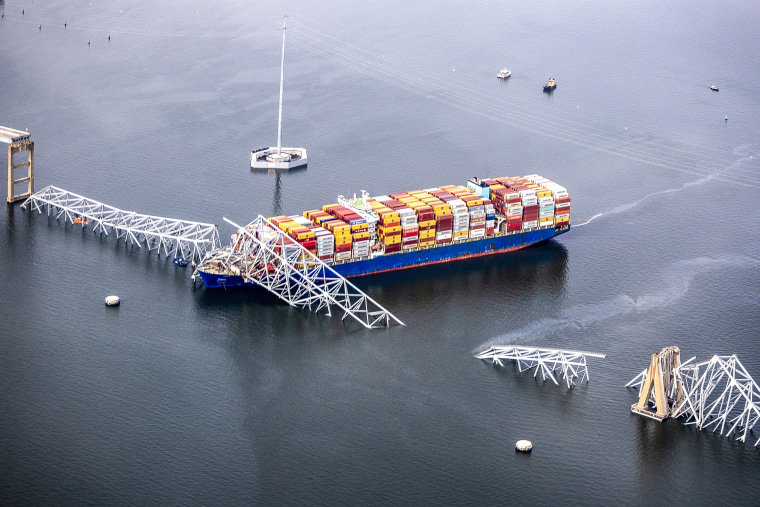
Writer David Simon, a champion of Baltimore who set his TV crime drama "The Wire" on the streets of the city he once covered as a reporter, warned online that the people who will suffer the most are those whose livelihoods depend on the port.
"Thinking first of the people on the bridge," Simon posted on X . "But the mind wanders to a port city strangling. All the people who rely on ships in and out."
Timeline of crash
Dramatic video captured the moment at 1:28 a.m. Tuesday when the Dali struck a support and sent the bridge tumbling into the water. A livestream showed cars and trucks on the bridge just before the strike. The ship did not sink, and its lights remained on.
Investigators said in a timeline that the Dali's lights suddenly shut off four minutes earlier before they came back on and that then, at 1:25 a.m. dark black smoke began billowing from the ship's chimney.
A minute later, at 1:26 a.m., the ship appeared to turn. And in the minutes before it slammed into the support, the lights flickered again.
Maryland Transportation Secretary Paul Wiedefeld said the workers on the bridge were repairing concrete ducts when the ship crashed into the structure.
At least seven workers were pouring concrete to fix potholes on the roadway on the bridge directly above where the ship hit, said James Krutzfeldt, a foreman.
Earlier, the Coast Guard said it had received a report that a “motor vessel made impact with the bridge” and confirmed it was the Dali, a containership sailing under a Singaporean flag that was heading for Sri Lanka.
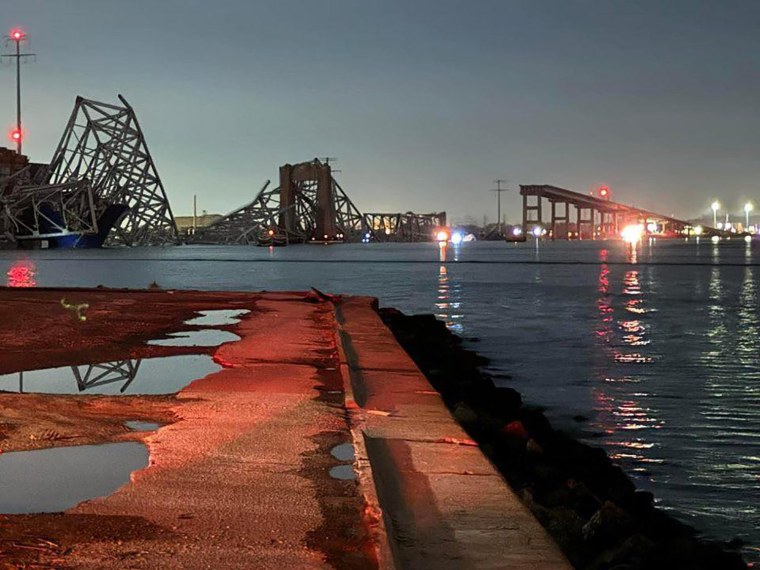
Bobby Haines, who lives in Dundalk in Baltimore County, said he felt the impact of the bridge collapse from his house nearby.
"I woke up at 1:30 this morning and my house shook, and I was freaking out," he said. "I thought it was an earthquake, and to find out it was a bridge is really, really scary."
Families of bridge workers wait for updates
Earlier in the day, relatives of the construction crew waited for updates on their loved ones.
Marian Del Carmen Castellon told Telemundo her husband, Miguel Luna, 49, was working on the bridge.
“They only tell us that we have to wait and that they can’t give us information,” she said.
Castellon said she was "devastated, devastated because our heart is broken, because we don’t know how they have been rescued yet. We are just waiting for the news."
Luna's co-worker Jesús Campos said he felt crushed, too.
“It hurts my heart to see what is happening. We are human beings, and they are my folks,” he said.
Campos told The Baltimore Banner that the missing men are from El Salvador, Guatemala, Honduras and Mexico.
Active search and rescue ends
The Coast Guard said it was suspending the active search-and-rescue effort at 7:30 p.m. Tuesday.
"Coast Guard’s not going away, none of our partners are going away, but we’re just going to transition into a different phase," Gilreath said at a news conference.
Maryland State Police Superintendent Roland L. Butler, Jr., said it was moving to a recovery operation. Changing conditions have made it dangerous for divers, he said.
Butler pledged to "do our very best to recover those six missing people," but the conditions are difficult.
"If we look at how challenging it is at a simple motor vehicle crash to extract an individual, I'm sure we can all imagine how much harder it is to do it in inclement weather, when it's cold, under the water, with very limited to no visibility," he said.
"There's a tremendous amount of debris in the water," which can include sharp metal and other hazards, and that could take time, Butler said.
'A long road in front of us'
Built in 1977 and referred to locally as the Key Bridge, the structure was later named after the author of the American national anthem.
The bridge is more than 8,500 feet long, or 1.6 miles. Its main section spans 1,200 feet, and it was one of the longest continuous truss bridges in the world upon its completion, according to the National Steel Bridge Alliance .
About 31,000 vehicles a day use the bridge, which equals 11.3 million vehicles per year, according to the Maryland Transportation Authority.
The river and the Port of Baltimore are both key to the shipping industry on the East Coast, generating more than $3.3 billion a year and directly employing more than 15,000 people.
Asked what people in Baltimore can expect going forward, the state's transportation secretary said it is too early to tell.
"Obviously we reached out to a number of engineering companies, so obviously we have a long road in front of us," Wiedefeld said.
Julia Jester reported from Baltimore, Patrick Smith from London, Corky Siemaszko from New York and Phil Helsel from Los Angeles.
Julia Jester is a producer for NBC News based in Washington, D.C.
Patrick Smith is a London-based editor and reporter for NBC News Digital.
Phil Helsel is a reporter for NBC News.
Corky Siemaszko is a senior reporter for NBC News Digital.
Tugboats left before ship reached Baltimore bridge. They might have saved it.

As investigators work to determine what caused the hulking Dali container ship to topple Baltimore’s Francis Scott Key bridge in a matter of seconds on Tuesday, maritime experts around the country are pointing to what could have stopped it.
These small but mighty vessels tow and push ever-larger ships through channels and help them when their propulsion systems – or lack thereof – cannot. They are standard equipment in ports worldwide and are especially useful to help ships with docking and undocking.
On Tuesday, a pair of tugboats operated by McAllister Towing and Transportation did just that, helping the Dali unmoor itself from the main terminal at the Port of Baltimore and orient the ship toward the open waters.
But they broke away before the massive ship navigated under the bridge , as is common practice. Minutes later, the Dali appeared to lose power and propulsion, sending the craft adrift and directly into one of the bridge’s support columns. The steel-truss bridge immediately collapsed into the frigid Patapsco River.
The accident is igniting debate over the proliferation of “megaships” that fuel today’s commercial transportation industry and whether port protocols have ramped up to safely accommodate them. Although the Dali is average-sized compared to many of these behemoths, the devastation it caused in Baltimore was formidable.
Live updates: Two bodies in Baltimore bridge collapse recovered; search for 4 others ends
Had the tugboats accompanied the ship all the way under the bridge, some experts said, they might have been able to stop, slow, or steer it away from danger.
Such a scenario should be standard operating procedure in all ports, said Capt. Ashok Pandey, a master mariner and associate professor of maritime business at the Massachusetts Maritime Academy. But he said the industry’s reliance on tugs has waned over the years as technological advancements gave many ships the ability to maneuver through channels independently.
Technology is great, Pandey said, until it fails.
“We went wrong by simply equipping ships with bow and stern thrusters that we use in lieu of tugs to maneuver in and out of the ports,” Pandey said. “When we are getting into ports like Baltimore, within a few miles of the bridge, that's too important an asset that we must think of protecting it by all means possible. And we can do that. We can easily do that.”
It may be rare for a ship to lose power at such a high-stakes moment, but it clearly does happen, and he said tugboats could have averted catastrophe.
Implementing such a practice would require a significant investment for U.S. ports, which either own and operate their own tugboats or contract out for tug services. Those costs are then rolled into the ports’ fees charged to shipping companies who use their facilities.
“There are a finite number of tugs, and 99.9% of the time there are no issues,” said Sal Mercogliano, a former merchant mariner and current maritime historian at Campbell University who also hosts a YouTube show called “What’s Going On With Shipping?”
“If the port required tug escorts in and out, then they would not be able to help other ships dock, and undock,” Mercogliano said. “It would need more tugs, and the question becomes, how much will this cost, and will it be passed on to the consumer?”
Because ports compete with each other for shipping business, he said, it’s unlikely that one port would mandate tug escorts unless all of the ports did it for fear of losing lucrative contracts. Shipping companies want the most efficient and cost-effective deal and will simply move to the next port if confronted with higher costs or longer waits.
Mercogliano said he’s not even sure tugboats would have been able to stop the Dali from hitting the bridge. When its power appeared to fail, the ship was going about 8 knots – roughly 9 mph – with a weight of over 100,000 tons.
“It would be like a Prius trying to move a Mack truck on the highway,” he said.
Realities of the container ship arms race
The Dali isn’t even big compared to other container ships hauling goods from port to port these days.
Over the past several decades, newly constructed ships have ballooned to gigantic proportions with load-carrying capacities that used to require five or six ships. The largest container vessel in the 1980s had a maximum capacity of 4,300 20-foot containers – otherwise referred to as TEUs, or 20-foot equivalent units – the standard unit of measurement for cargo capacity.
Today’s largest ship, the MSC Irina, has a capacity of 24,346 TEUs.
The Dali, by comparison, has a capacity of just under 10,000 TEUs, making it the typical “meat and potatoes of container ships,” said Kevin Calnan, assistant professor of marine transportation at California State University Maritime Academy.
Like most container ships, Calnan said, the Dali has one engine and one propeller. Its emergency diesel generator, standard in all such vessels, has enough power to keep key systems going – but not enough to restart the engine or provide propulsion.
In a video posted to social media, lights on the Dali shut off, then turned back on, then shut off again before the ship struck the bridge. Experts said that was likely the generator as it powered up the lights but not the engine.
It would have taken a second engine on board to fully power the ship and restore propulsion at that point. But Calnan said nobody in the commercial shipping industry is advocating for two engines because of their size and cost.
“Cargo is money, and companies want to maximize the amount of space they want to put cargo in, so to build a ship with a whole other engine would be taking up the space of, like, 150 containers on that ship,” he said. “Unfortunately, there’s not too much movement to require these ships to have two engines.”
Calnan, who has worked and sailed on numerous ships during his career, is among the experts who believe tugboats “definitely” could have stopped the Dali from hitting the bridge. He said he has been in similar situations where the power went out and “having tugs there basically saved the day.”
It may take a disaster for industry and ports to change
The bigger the boats and the more sophisticated the technology, the fewer the crew members on board. The Dali's crew is 22-strong.
In his 26 years sailing on commercial ships, Capt. Mike Campbell said he witnessed that shift to smaller crews as automation and electronics made it possible to do more with less when it came to docking, navigating and maintaining the engines.
“I had captains who would turn the radar off in the middle of the day because they didn't want to wear it out, and you'd just go off visual cues, take readings off lighthouses. Now everything is chips and boards,” he said. “And people are more dependent or reliant on it because they are more reliable.”
Campbell, now a professor at the Massachusetts Maritime Academy and master of the training ship Kennedy, said he’s also seen captains push to meet tight schedules, recalling a time when several other chemical carriers owned by competitors sailed out of the Port of Philadelphia into bad weather. His ship stayed put for three days, and arrived in Houston, safely, a day behind schedule. The other ships, he said, all had to sail to shipyards for repairs caused by the storm.
“I was fortunate that the people I sailed under, my mentors, they never worried about the schedule. It was always about the safe operation of the ship,” he said. “You don't want to push things.”
Mariners are always worried about their schedules now, Pandey said.
The shipping industry has become so highly competitive, with companies all vying for a slice of the business, that crews are more likely to leave port without containers than wait on a late shipment and risk falling behind. Ships typically go from port to port, spending anywhere from six to eight hours in each before moving on to the next.
He called it a race to nowhere in which everyone – from the ports to the shipping companies – is playing along.
U.S. ports have spent billions of dollars over the years adapting to the new reality – upgrading their facilities and dredging their channels deep enough to accommodate these massive ships. Some experts warn they could get even bigger in the future, possibly doubling in cargo capacity at some point.
Amid the race to compete for the revenue and jobs brought by these ever-larger ships, port authorities seem to have forgotten about protecting their critical infrastructure, according to Pandley, the former master mariner. He said Tuesday’s accident might be the wake-up call they need to do some real soul-searching.
USA TODAY reached out to the American Association of Port Authorities to ask its thoughts on requiring tug escorts or any other measures to avert the kind of disaster that happened in Baltimore, but a spokesman said nobody was immediately available to take those questions.
Unfortunately, experts said, it often takes a tragedy to improve an industry.
That’s what happened after the 1989 Exxon-Valdez oil spill in Alaska when the U.S. government required double-hull construction for all newly built oil tank ships and all oil tank barges in American waters. California passed a law in the aftermath of that disaster, requiring all oil tankers to have tug escorts in its ports and harbors.
“We have a saying that the laws are written in blood,” said Roland Rexha, international secretary-treasurer of the Marine Engineers’ Beneficial Association, the oldest maritime union in the United States.
“Knowing what we know now, could we have had tugs accompany the ship to the bridge? Sure. But what were the issues that caused the vessel to lose power in the first place?” he said. “There will be an investigation, and we’re hopeful that the lessons learned will lead to an active change in how things are operated.”
Six people presumed dead after Baltimore Key Bridge collapses, Coast Guard says
A major bridge in Baltimore collapsed after being hit by a freighter about 1:30 a.m. Tuesday, sending at least eight people from a construction crew into the water as a large section of the bridge crashed into the Patapsco River. Six people were presumed dead Tuesday evening, authorities announced as they shifted from a search and rescue operation to a recovery effort. The container ship lost power moments before it struck the Francis Scott Key Bridge, Maryland Gov. Wes Moore (D) said at a news conference.
- Ship’s pilot tried to slow the vessel as it veered toward bridge, trade association says
- Rescue operation ends with six presumed dead
- Baltimore community gathers for vigil honoring bridge collapse victims
Here's what to know:
Here's what to know, live coverage contributors 50.

10:22 a.m. EDT 10:22 a.m. EDT
12:03 a.m. EDT 12:03 a.m. EDT
10:50 p.m. EDT 10:50 p.m. EDT
10:25 p.m. EDT 10:25 p.m. EDT
9:57 p.m. EDT 9:57 p.m. EDT
9:30 p.m. EDT 9:30 p.m. EDT
9:03 p.m. EDT Reporting from Baltimore 9:03 p.m. EDT
9:00 p.m. EDT Bullet Key update 9:00 p.m. EDT
8:25 p.m. EDT Bullet Key update 8:25 p.m. EDT
8:01 p.m. EDT Bullet Key update 8:01 p.m. EDT
7:49 p.m. EDT 7:49 p.m. EDT
7:31 p.m. EDT 7:31 p.m. EDT
6:56 p.m. EDT 6:56 p.m. EDT
6:45 p.m. EDT 6:45 p.m. EDT
6:16 p.m. EDT 6:16 p.m. EDT
6:14 p.m. EDT 6:14 p.m. EDT
6:00 p.m. EDT 6:00 p.m. EDT
5:58 p.m. EDT 5:58 p.m. EDT
5:16 p.m. EDT 5:16 p.m. EDT
5:06 p.m. EDT 5:06 p.m. EDT
4:58 p.m. EDT Bullet Key update 4:58 p.m. EDT
4:31 p.m. EDT 4:31 p.m. EDT
4:29 p.m. EDT 4:29 p.m. EDT
4:24 p.m. EDT 4:24 p.m. EDT
4:21 p.m. EDT 4:21 p.m. EDT
4:17 p.m. EDT 4:17 p.m. EDT
4:16 p.m. EDT 4:16 p.m. EDT
4:11 p.m. EDT 4:11 p.m. EDT
4:09 p.m. EDT 4:09 p.m. EDT
3:35 p.m. EDT 3:35 p.m. EDT
3:34 p.m. EDT 3:34 p.m. EDT
3:12 p.m. EDT 3:12 p.m. EDT
3:10 p.m. EDT 3:10 p.m. EDT
3:09 p.m. EDT 3:09 p.m. EDT
2:58 p.m. EDT 2:58 p.m. EDT
2:56 p.m. EDT 2:56 p.m. EDT
2:22 p.m. EDT 2:22 p.m. EDT
2:19 p.m. EDT 2:19 p.m. EDT
2:11 p.m. EDT 2:11 p.m. EDT
1:31 p.m. EDT 1:31 p.m. EDT
1:23 p.m. EDT 1:23 p.m. EDT
1:14 p.m. EDT 1:14 p.m. EDT
12:47 p.m. EDT 12:47 p.m. EDT
12:38 p.m. EDT 12:38 p.m. EDT
12:27 p.m. EDT 12:27 p.m. EDT
11:58 a.m. EDT 11:58 a.m. EDT
11:56 a.m. EDT 11:56 a.m. EDT
11:55 a.m. EDT 11:55 a.m. EDT
11:49 a.m. EDT 11:49 a.m. EDT
11:45 a.m. EDT 11:45 a.m. EDT
11:36 a.m. EDT 11:36 a.m. EDT
11:32 a.m. EDT 11:32 a.m. EDT
11:17 a.m. EDT 11:17 a.m. EDT
11:15 a.m. EDT 11:15 a.m. EDT
11:02 a.m. EDT 11:02 a.m. EDT
10:58 a.m. EDT 10:58 a.m. EDT
10:53 a.m. EDT 10:53 a.m. EDT
10:47 a.m. EDT Bullet Key update 10:47 a.m. EDT
10:35 a.m. EDT 10:35 a.m. EDT
10:34 a.m. EDT 10:34 a.m. EDT
10:24 a.m. EDT 10:24 a.m. EDT
10:19 a.m. EDT Bullet Key update 10:19 a.m. EDT
10:14 a.m. EDT 10:14 a.m. EDT
10:10 a.m. EDT 10:10 a.m. EDT
10:05 a.m. EDT 10:05 a.m. EDT
10:02 a.m. EDT 10:02 a.m. EDT
9:44 a.m. EDT 9:44 a.m. EDT
9:32 a.m. EDT 9:32 a.m. EDT
9:30 a.m. EDT Bullet Key update 9:30 a.m. EDT
9:22 a.m. EDT 9:22 a.m. EDT
9:18 a.m. EDT 9:18 a.m. EDT
9:17 a.m. EDT 9:17 a.m. EDT
9:09 a.m. EDT Bullet Key update 9:09 a.m. EDT
9:00 a.m. EDT 9:00 a.m. EDT
8:51 a.m. EDT 8:51 a.m. EDT
8:35 a.m. EDT Bullet Key update 8:35 a.m. EDT
8:29 a.m. EDT Bullet Key update 8:29 a.m. EDT
8:19 a.m. EDT 8:19 a.m. EDT
8:15 a.m. EDT 8:15 a.m. EDT
7:59 a.m. EDT 7:59 a.m. EDT
7:46 a.m. EDT Bullet Key update 7:46 a.m. EDT
7:21 a.m. EDT 7:21 a.m. EDT
7:18 a.m. EDT 7:18 a.m. EDT
6:52 a.m. EDT 6:52 a.m. EDT
6:49 a.m. EDT Bullet Key update 6:49 a.m. EDT
6:18 a.m. EDT 6:18 a.m. EDT
5:51 a.m. EDT Bullet Key update 5:51 a.m. EDT
5:31 a.m. EDT 5:31 a.m. EDT
5:27 a.m. EDT 5:27 a.m. EDT
5:19 a.m. EDT 5:19 a.m. EDT
5:13 a.m. EDT 5:13 a.m. EDT
5:00 a.m. EDT Reporting on the scene from Baltimore 5:00 a.m. EDT
4:41 a.m. EDT 4:41 a.m. EDT
4:40 a.m. EDT 4:40 a.m. EDT
4:24 a.m. EDT Bullet Key update 4:24 a.m. EDT
4:18 a.m. EDT Bullet Key update 4:18 a.m. EDT
4:12 a.m. EDT 4:12 a.m. EDT


IMAGES
VIDEO
COMMENTS
Sea fog appears most often during the summer, especially at night and during the morning. It is thickest when the wind is light and tends to thin as the sun shines brighter and winds pick up in the afternoon. Radiation fog. Also called ground fog, this usually forms at night and in the early morning when the air is still and the sky clear.
Besides the sailboat underway in fog signal mentioned here, you should also learn all the other sound signals that apply to restricted visibility: One prolonged blast every 2 minutes. This means, "I'm moving!" and is made by a motor-driven vessel underway and moving through the water. Two prolonged horn blasts in succession with 2-second ...
It is always time to review fog signals while underway. All vessels underway in or near an area of restricted visibility, whether day or night, must make the following fog signals: Power driven vessel making way - A powerboat making way through the water must sound one. prolonged blast at intervals of not more than 2 minutes.
Boats less than 39.4 feet in length - must carry an efficient sound producing device. In general, this may be a bell, whistle, or air horn. ... Only the fog signals listed under the Inland Rules, Rule 35 may be sounded at such time. Signals. Sound signals are called "blasts". There are two different blasts used for warning and steering signals.
Know Fog Sound Signals. Navigating in foggy conditions can be tricky. If you're a powerboat operator, the International Regulations for Preventing Collisions at Sea provide a set of sound signals to help others understand where your boat is and what it's doing-whether underway or drifting.
The moment fog sets in, the skipper or navigator should plot the boat's position as precisely as possible on the chart or determine its most likely position. The radar reflector should be switched on. If it is not fixed on the boat, place it as high as possible on the rigging. As the vast majority of vessels on the open sea use radar to avoid a ...
Discounts on fuel, transient slips, repairs and more at over 1,200 businesses. Deals on cruises, charters, car rentals, hotel stays and more…. All for only $25/year! Even with all the electronic eyes and ears on our modern vessels, fog at sea can bring on disorientation, panic, and danger.
Sea fog, or advection fog, forms when relatively warm moist air moves over colder water and cools to its dew point temperature, causing the air to saturate. Unlike land fog, or radiation fog, sea ...
But when the fog rolled in overnight, and the southeasterly winds persisted the next morning, we knew we weren't going to be able to avoid traveling in the fog. We delayed as much as possible, spending time below going over sail theory, sail trim and learning the nuts and bolts of navigation in the fog. But 1100 came, and we had to catch the ...
I am a sailboat in fog. Remember this by an average sailboat normally has two sails- thus the two shorts toots. Powerboat if Fog. Where prolonged is a prolonged blast (lasting 4 to 6 seconds) and signals are not more than 2 minutes apart. This signal above (one prolonged and two short) is also the signal for other vessels operating in fog such ...
June 15, 2022. Sailing is the art of using the wind to move slowly at great expense. That act becomes substantially less satisfying, when hampered with reduced visibility. Sailing in fog, darkness, or any other reduced visibility can bring a myriad of terrors from navigational hazards, other boats, and even the wind itself.
Sound signals are used to warn other boaters or alert them to danger. One prolonged blast is a warning signal (for example, used when coming around a blind bend or leaving the dock). Five (or more) short, rapid blasts are used to signal danger or to signal that you do not understand or you disagree with the other boater's intentions. Unit 2 of 6.
Short answer: A sailboat is underway in the fog: When a sailboat is underway in the fog, it means that it is sailing while visibility is significantly reduced due to dense fog. This poses challenges as the boat's crew must rely on navigation instruments and sound signals to safely navigate through potentially hazardous conditions.
Sound-Producing Devices And Characteristics. Sound signals are described as "blasts," of which there are two types: A "short blast" means a blast of about 1 second, while a "prolonged blast" is 4 to 6 seconds. The word "whistle" is defined in the Navigation Rules as any sound-signaling device capable of producing the required blasts as ...
5. Lifejackets and harnesses. Put on lifejackets. Not only is this a sensible precaution, it also alerts the crew that conditions may become serious. In calm weather (quite likely in fog), you don't want to be tethered to the boat in the event of a collision, so probably best not to hook on.
- Restricted Visibility: In times of reduced visibility due to fog, mist, heavy rain, or darkness, boats should make use of specific sound signals to inform others of their presence and navigate safely. A power-driven vessel underway should provide one prolonged blast every two minutes. 4. Avoiding Confusion:
A vessel engaged in fishing (lines, nets or trawling) must sound one long and two short blasts, again at intervals no longer than two minutes. Interestingly, this is the same signal required of a sailboat under sail. Go figure. **When Anchored. **Anchored boats shorter than 39.4 feet LOA must make some noise (preferably with a bell) every two ...
Two sailboats entering the port of Rijeka. Browse Getty Images' premium collection of high-quality, authentic Sailboat In Fog stock photos, royalty-free images, and pictures. Sailboat In Fog stock photos are available in a variety of sizes and formats to fit your needs.
Kessel advises that any prudent boater should delay getting underway when fog is present or forecast. However, if you're caught in fog, you can take three immediate actions to stay safe: ... AIS makes a full-size target image on the other boat's monitor regardless of the size or type of boat transmitting the AIS data. Fish finders and sonar ...
Sound signaling device: Sound signaling devices are one of the most important tools to have on board, especially during periods of heavy fog and reduced visibility. The three main types of sound signaling devices are air horns, whistles, and ship bells. Air horns are ideal for portability and emitting loud, easily recognizable sounds.
Here is the some simple steps that you should follow for signals: 1 Extended Blast and more then 3 short Blasts every 2 minutes. You can use Red Star Shells To let other boater know. Use Fog Horn continuous soundings. Flames on a vessel. Gun fired at Intervals of One Minute.
Moderate: 2 to 5 nautical miles. Good: Greater than 5 nautical miles. Learning to navigate through fog (or avoiding it) is critical to safe boating. These safety tips will help to keep you safe: Slow down to avoid collisions. Turn on all of your running lights, even in daytime. Listen for sounds of other boats that may be near you or for fog ...
For powerboats, a prolonged blast of the horn is the appropriate sound signal. This is a sound that lasts for four to six seconds and should be used every two minutes when underway in foggy conditions. Sailing vessels, on the other hand, should use a combination of sound signals.
The ship's speed over ground was recorded at just under 8 miles per hour. From this moment until approximately 1:29:33, the VDR audio recorded sounds consistent with the collision with the bridge.
In police radio from March 26, officers attempt to hold traffic on Baltimore's Francis Scott Key Bridge after claiming a ship lost control of its steering. (Video: Broadcastify) At 1:28 a.m. the ...
484. Advertisement. A major bridge in Baltimore collapsed after being struck by a cargo ship early Tuesday, sending vehicles plunging into the water and setting off an emergency response.
The Dali was less than 30 minutes into its planned 27-day journey when the ship ran into the Francis Scott Key Bridge on Tuesday.. The ship, which was sailing under the Singaporean flag, was on ...
The Francis Scott Key bridge in Baltimore, Maryland, partially collapsed early Tuesday, police said. It was hit by a ship, officials said.
Live updates:Two bodies in Baltimore bridge collapse recovered; search for 4 others ends Had the tugboats accompanied the ship all the way under the bridge, some experts said, they might have been ...
The Francis Scott Key Bridge in Baltimore collapsed after being hit by a freighter. Emergency rescuers removed two people from the water and are looking for others.